#Economic integration Black Sea
Explore tagged Tumblr posts
Text
United We Stand: The Need for Increased Cooperation in the Black Sea Region
by Eastern European Institute for Trade

Fostering unity is crucial for the Black Sea Region, as increased cooperation holds the key to unlocking the region’s full potential. The Black Sea Region, encompassing countries such as Bulgaria, Georgia, Romania, Russia, and Turkey, shares cultural, historical, and economic ties. However, a more concerted effort to strengthen these ties and facilitate collaboration can significantly benefit all involved nations (Manoli, 2012).
The region’s strategic position at the crossroads of Europe and Asia, alongside its wealth of natural resources, provides ample opportunities for growth and development. Consequently, an integrated approach to economic cooperation is essential for regional progress (Ayça & Ümit, 2015). To this end, the Black Sea Economic Cooperation (BSEC) organization, founded in 1992, has aimed to transform the Black Sea into a region of peace, stability, and prosperity by promoting economic collaboration and fostering goodwill among member states (BSEC, 2020).
One key area that demands increased cooperation is energy security. The Black Sea Region is a critical energy transit corridor, with its abundant natural resources and multiple pipeline networks supplying Europe with oil and gas (EIA, 2014). Ensuring energy security through diversified supply routes and sources is vital for the region’s stability and economic growth. Enhanced collaboration between regional stakeholders can help mitigate potential disruptions and guarantee energy supplies for all countries involved (Çalışkan & Kapusuz, 2017).
Another sphere that would benefit from closer ties is trade. By removing barriers to trade, enhancing cross-border transport infrastructure, and harmonizing regulations, the region can foster economic growth and improve competitiveness (Aslund & Dabrowski, 2008). Additionally, regional countries can work together to attract foreign direct investment by providing a stable and transparent business environment. A coordinated approach to investment promotion can also help leverage the region’s strengths and address common challenges (Gotev, 2016).
Lastly, the Black Sea Region must work collectively to address the pressing issue of environmental protection. The Black Sea is a unique ecosystem that faces threats from pollution, overfishing, and climate change (BSC, 2017). By implementing joint policies, sharing best practices, and monitoring compliance, the region can effectively tackle these challenges and preserve its environment for future generations (Kıvanç & Güler, 2018).
In conclusion, the Black Sea Region stands to gain significantly from increased cooperation among its member countries. By focusing on energy security, trade, investment, and environmental protection, the region can foster economic growth, improve competitiveness, and ensure a sustainable future. United, the Black Sea Region can achieve much more than it could through individual efforts.
References:
Aslund, A., & Dabrowski, M. (2008). Challenges of globalization: Imbalances and growth. Peterson Institute for International Economics.
Ayça, A. D., & Ümit, E. (2015). The impact of BSEC on economic cooperation among member states. Procedia Economics and Finance, 23, 568–574.
BSEC. (2020). Black Sea Economic Cooperation. Sourced from http://www.bsec-organization.org
BSC. (2017). State of the Environment of the Black Sea. Sourced from http://www.blacksea-commission.org
Çalışkan, E., & Kapusuz, A. G. (2017). The importance of energy security in the Black Sea region. Perceptions, 22(2), 67–89.
EIA. (2014). Europe’s Dependence on Black Sea Energy. U.S. Energy Information Administration.
Gotev, G. (2016). Eastern Partnership countries eye closer cooperation on energy issues. Euractiv.
Kıvanç, A., & Güler, E. (2018). Environmental challenges and prospects for cooperation in the Black Sea region. Journal of Black Sea Studies, 15(59), 123–140.
Manoli, P. (2012). The dynamics of Black Sea subregionalism. Farnham, Surrey: Ashgate Publishing.
Yılmaz, S., & Erdem, H. (2014). The role of BSEC in regional economic cooperation and its future potential. International Journal of Economic and Administrative Studies, 7(13), 169–198.
Read more at Eastern European Institute for Trade.
#EEIT#Eastern European Institute For Trade#Black Sea Region cooperation#Regional collaboration Eastern Europe#Black Sea Economic Cooperation#BSEC member countries#Eastern European geopolitics#Economic integration Black Sea
0 notes
Text
SAINTS&READING: WEDNESDAY, SEPTEMBER 4, 2024
august 22_september 4
MARTYR AGATHONICUS OF NICOMEDIA, AND THOSE WITH HIM, WHO SUFFERED UNDER MAXIMIAN (4th c.)

The Martyrs Agathonicus, Zoticus, Theoprepius, Acindynus, Severian, Zeno and others accepted death for Christ during the reign of the emperor Maximian (284-305).
The Martyr Agathonicus was descended from the illustrious lineage of the Hypasians, and he lived at Nicomedia. Well versed in Holy Scripture, he converted many pagans to Christ, including the most eminent member of the Senate (its “princeps” or leader). Comitus Eutolmius was sent to the Pontine (lower Black Sea) region, where he crucified the followers of the Christian Zoticus, who had refused to offer sacrifice to idols. He took Zoticus with him.
In Nicomedia, Eutolmius arrested the Martyr Agathonicus (together with the princeps), and also Theoprepius, Acindynus and Severian. After tortures, Eutolmius ordered that the martyrs be taken to Thrace for trial by the emperor.
But along the way, in the vicinity of Potama, the Martyrs Zoticus, Theoprepius and Acindynus were unable to proceed further behind the chariot of the governor because of wounds received during torture. Therefore, they were put to death. The Martyr Severian was put to death at Chalcedon, and the Martyr Agathonicus together with others was beheaded with the sword by order of the emperor, in Selymbria.
The relics of the Martyr Agathonicus were in a church named for him at Constantinople, and were seen in the year 1200 by the Russian pilgrim Anthony. And in the fourteenth century Philotheus, the archbishop of Selymbria, devoted an encomium to the Martyr Agathonicus.
VENEABLE ISAAC ( ANTIMONOV, THE "ELDER" OF OPTINA(1894)

Saint Isaac, in the assembly of Optina elders, represents a type of ascetic-builder. For 32 years, he headed Optina Monastery, devoting himself entirely to the monastery, taking care of the brethren, continuing to create that particular “Optina” spirit that his predecessors planted. He took over the management of the monastery after the death of Archimandrite Moses. He was abbot during the flourishing of the monastery—during the time of the Elder Ambrose, and his successors in eldership, Father Hilarion and Father Anatoly (the Elder). Under his leadership, the future Elders Joseph, Barsanuphy, and Anatoly (the Younger) grew and developed. Archimandrite Moses revived Optina Monastery after a period of desolation, and Father Isaac continued his work, consolidating the state of the monastery, while not sparing himself from hard labor for its improvement. Elders Macarius and Ambrose blessed him in the difficult obedience of superior, seeing the high spiritual qualities, prayerfulness, simplicity, and humility of Father Isaac, and from these the ability to take care of the organization of the monastery—both external and internal.
It may seem that the Elder Isaac, who carried the cross of superiorship, dwells, as it were, in the shadow of the elders who spiritually nurtured the monks and pilgrims of the monastery—Ambrose, Hilarion, and Anatoly. Little of his teachings and statements were saved, so there are no such detailed memories of him. But this is his special achievement—by carrying the heavy burden of economic affairs of the monastery, he served the brethren and pilgrims, revealing an amazing height of humility. Behind his simplicity is an amazing depth, integrity, and strength of spirit. The period of his superiorship was the best time in the life of Optina.
Antimonov Family
Ivan Ivanovich Antimonov (the name of Saint Isaac in the world) was born on May 31, 1810, and was descended from an eminent, wealthy merchant family of the city of Kursk. The Antimonovs had the title of honorary citizens. The patriarchal spirit reigned in the house of the Antimonovs; the way of life was built strictly in accordance with Church rules, and only respect towards elders and obedience to them were accepted. Thus, the skills of piety and obedience, which are so important for a monk, the future ascetic received in his own home.
The head of the house was Ivan's grandfather—Vasily Vasilyevich Antimonov. He was particularly zealous to attend divine services. His eldest son Ivan Vasilyevich had thirteen children from three marriages. Ivan Jr. was the last, fifth child from his first marriage with Anna Puzanov. Little Ivan was a favorite of his grandfather, who often took his grandson with him to the church. Vasily Vasilyevich visited the church every day—he went without fail to the Matins and Vespers services.
Ivan Vasilyevich inherited his father’s piety and love for the Church, according to his upbringing; his simplicity and good disposition towards people produced a favorable impression on everyone. A family story is preserved about Saint Isaac’s father’s journey to Kiev in 1809 to the elder, Hieromonk Parfeny, who greeted Ivan Vasilyevich with the words: “Blessed be the womb that gave birth to a monk.” In raising the young Ivan and other children, he adhered to strict rules but never allowed himself to be rude to the children. He did not raise his hands at them—although at that time this was common in merchant families. The children, while behaving respectfully towards their father, loved him at the same time.
The Antimonov family enjoyed universal respect in the city for impeccable honesty, true piety, and wide charity—they were generous donors for Church needs and helped the needy. In the house there was even a certain day of the week appointed in which alms were given to the poor.
It was in such an atmosphere that Ivan Ivanovich’s years of childhood and youth passed. Details about this period of his life do not survive, but it is known that he was distinguished by modesty and was fond of silence. At the same time, despite his reserved nature, Ivan was endowed with natural gaiety and wit; his presence always enlivened family gatherings.
Life in the World
Upon reaching mature age, Ivan Ivanovich began to help his father in trade affairs. He constantly had to deal with people, give orders, and conduct financial calculations. He knew how to find an approach to a man, and he won people over by his heartfelt kindness and sense of justice. He had the most beneficial influence on his subordinates; he forced them to end any habit of fraud, any attempts to act deceitfully. Immaculate honesty in business earned Ivan Ivanovich universal respect.
Although strict in his requirements, the venerable one never took offense. Such a case is known: one of his workers, a man of obstinate nature, because of the constant punishments that Ivan Ivanovich gave him for carelessness and audacity, decided in his mind to kill him. When this became known to him, Ivan Ivanovich forgave the worker and released him, not handing him over to the hands of justice... Continue reading


2 Corinthians 3:4-11
4 And we have such trust through Christ toward God. 5 Not that we are sufficient of ourselves to think of anything as being from ourselves, but our sufficiency is from God, 6 who also made us sufficient as ministers of the new covenant, not of the letter but of the Spirit; for the letter kills, but the Spirit gives life. 7 But if the ministry of death, written and engraved on stones, was glorious, so that the children of Israel could not look steadily at the face of Moses because of the glory of his countenance, which glory was passing away, 8 how will the ministry of the Spirit not be more glorious? 9 For if the ministry of condemnation had glory, the ministry of righteousness exceeds much more in glory. 10 For even what was made glorious had no glory in this respect, because of the glory that excels. 11 For if what is passing away was glorious, what remains is much more glorious.
Matthew 23:29-39
29 Woe to you, scribes and Pharisees, hypocrites! Because you build the tombs of the prophets and adorn the monuments of the righteous, 30 and say, 'If we had lived in the days of our fathers, we would not have been partakers with them in the blood of the prophets.' 31 Therefore, you are witnesses against yourselves that you are sons of those who murdered the prophets. 32 Fill up, then, the measure of your father's guilt. 33 Serpents, brood of vipers! How can you escape the condemnation of hell? 34 Therefore, indeed, I send you prophets, wise men, and scribes: some of them you will kill and crucify, and some of them you will scourge in your synagogues and persecute from city to city, 35 that on you may come all the righteous blood shed on the earth, from the blood of righteous Abel to the blood of Zechariah, son of Berechiah, whom you murdered between the temple and the altar. 36 Assuredly, I say to you, all these things will come upon this generation. 37 O Jerusalem, Jerusalem, the one who kills the prophets and stones those who are sent to her! How often I wanted to gather your children together, as a hen gathers her chicks under her wings, but you were not willing! 38 See! Your house is left to you desolate; 39 for I say to you, you shall see Me no more till you say, 'Blessed is He who comes in the name of the LORD!'
#orthodoxy#orthodoxchristianity#easternorthodoxchurch#originofchristianity#spirituality#holyscriptures#gospel#bible#wisdom#faith#saints
4 notes
·
View notes
Text
The 44th General Assembly of the Union of Road Transport Associations in the Black Sea Economic Cooperation Region (BSEC-URTA) and various major international transport events are currently underway in Tashkent, Uzbekistan, from September 2 to 6. The Chamber of Motor Carriers in Bulgaria is participating in this forum, which focuses on transportation policies and international cooperation. During the assembly, Bulgaria faced strong criticism for the disorganization at its border crossings.
Leaders from two major international organizations, IRU and BSEC-URTA, have expressed their disapproval of Bulgaria's handling of border issues, emphasizing the broader impact of local actions on global transport networks. Turkey and Greece have reportedly collaborated to seek an alternative transport corridor that would bypass Bulgaria. Negotiations are ongoing to determine whether this new route will involve the Ipsalav-Kipi border crossing or another ferry route.
BSEC-URTA's official statement highlighted concerns about Bulgaria's recent decision, made unexpectedly at the end of July 2024, to reinstate vehicle disinfection procedures at the "Captain Andreevo" and "Lesovo" checkpoints. The organization anticipates that Turkey will likely introduce similar measures on its borders with Bulgaria, further exacerbating delays. BSEC-URTA has urged both Bulgarian and Turkish members to press their national authorities to remove these inefficient and costly measures, which are significantly impacting logistics in the Black Sea region.
Despite efforts by international transport organizations to promote efficient and secure road transport through integrated systems and market connections, Bulgaria is accused by the Chamber of Motor Carriers of applying double standards and discriminatory practices concerning parking and disinfection fees. The Chamber criticized Bulgaria's reluctance to address warnings and proposals from transport organizations, warning that failure to adapt could isolate the country as global transport dynamics evolve.
4 notes
·
View notes
Text
Europe’s never-ending struggle to provide tidbits of assistance to Ukraine while still pandering to the agricultural lobbies that dictate so much policy in Brussels took another tortured turn this week. The European Commission hammered out its latest, tentative compromise plan to offer Kyiv another year of tariff-free access to the European single market for some agricultural products—but it’s not a done deal, and it could end up as a nasty tripwire for Ukraine’s hopes to join the European Union.
At issue is a monthslong tussle over the renewal of tariff-free access for a handful of Ukrainian farm goods, such as eggs, poultry, honey, and maize (corn). Ukraine, which is not a member of the EU and is in the middle of a war with Russia, desperately wants the trade relief, which it figures is worth well over 1 billion euros a year in much-needed export earnings.
Europe as a whole is unlikely to be concerned about such rounding-error figures, but certain groups in Europe—namely farmers in eastern “front-line” countries—care very much indeed. Farmers in Poland have added angry chants against Ukrainian food imports to the standard-issue complaints about the European Green Deal and free trade that animate farmer protests across the continent; they’ve even blocked the borders east and west in protest against what they say is a flood of outside food that is undermining their livelihood.
In a nutshell, Europe’s bid to offer Ukraine the tiniest of economic lifelines is threatening to weaken support for the country’s eventual membership in the EU by angering groups with outsized political influence that feel threatened by what looks to them like the stealth arrival of a new trade rival. That is most evident in Poland, Ukraine’s neighbor, which when the war began was hugely supportive of aiding Kyiv in any way possible but which in recent months has become a lot more sour on defense assistance, Ukrainian refugees, Ukrainian wheat, and, of course, Ukrainian EU membership.
According to recent opinion polls, support among Poles for further aid to Ukraine is dropping sharply, and that is especially true among more right-wing voters (as is true across much of Europe). One big reason for this decline in support is the fight that Polish farmers have waged against what they see as a flood of cheap, foreign food.
“What I can say is that the support for Ukraine has taken a real hit in Poland. Look at enlargement, support for refugees, even weapons,” said Isabell Hoffmann, a survey expert at Eupinions, an independent platform for European public opinion. “Support was extraordinarily strong before, and it is still strong today. But it weakened notably and quickly.”
Poland has been fighting over Ukrainian food imports for a year, but the protests intensified at the beginning of this year with further border blockages and anti-Ukraine animus which have found widespread popular support.
“This issue has become very toxic in domestic politics. There are more and more critical voices in Poland,” said Piotr Buras, the head of the Warsaw office of the European Council on Foreign Relations (ECFR). “This is the paradox: The European Commission is talking about more gradual integration with Ukraine and the single market, but we are talking about the gradual closing of the single market for Ukraine.”
All this began, like so many of Ukraine’s current woes, with the full-scale Russian invasion in early 2022, which threatened Ukraine’s breadbasket agricultural regions and, importantly, its main export route through the Black Sea. The EU offered emergency tariff relief for a host of Ukrainian agricultural goods so they could travel overland and into the EU and trade without prejudice.
For Ukraine, desperate to earn foreign currency and boost the few exports that were left after the Russian invasion, it was a tidy little lifeline.
“From an economic point of view, agriculture remains one of the key export sectors of Ukraine,” said Marek Dabrowski, an expert on European trade and enlargement issues at Bruegel, a think tank. “Before the war, it was metallurgy and industry, but then part of that was destroyed, and part is occupied, so exports now are essentially down to agricultural goods. The reason for these ‘emergency measures’ has not gone away.”
Indeed, those emergency measures have continued every year since—until now. The European Commission planned to simply roll the tariff relief over this year, giving Ukraine one more year of free access, worth about 1.7 billion euros for Kyiv’s empty coffers. But many of the countries bordering Ukraine, including Hungary, Poland, and Slovakia, pushed back at what they viewed as a flood of cheap Ukrainian grain that was undermining their own farmers. Some countries, such as Poland, unilaterally blocked Ukrainian farm goods from staying in the country.
Together, and most recently backed by France, those countries pushed for a tougher version of tariff relief for Ukraine that would have limited the amount of agricultural goods it could sell to Europe. The European Commission and European Parliament have been at work hammering out ever-tougher versions of tariff relief ever since.
The latest proposal would still offer Ukraine relief for another year but with tougher quota baselines, which would cost Kyiv about 350 million euros annually. Ukraine’s farm lobby on Thursday decried the slide toward EU “protectionism” in the latest wrangling. But even that compromise measure still has to pass the European Parliament, where it could face yet further efforts to weaken Ukraine’s access.
While an extension, even a watered-down one, would still be welcome in Ukraine, the problem is the perception that such preferential trade policies create in front-line countries such as Poland. Ukrainian grain is not the cause for the plight of Polish farmers any more than it is the reason for angst in the countryside in the other 26 EU member states; that has a lot more to do with falling prices for global agricultural staples such as wheat, as well as slightly tougher (and costlier) EU regulations on agricultural production.
But many who are getting kicked while they are down don’t look carefully at precisely who is doing the kicking, and continual European assistance for Ukraine rubs many in the east the wrong way.
The temporary trade measures amounted to a full opening, Buras of ECFR said. “Basically, Ukraine jumped from a piecemeal opening to European access to the final stage of this process,” he said. “Nobody expected these measures to remain in place for three years or more. Technically, we have a full opening of the single market to Ukrainian products.”
The risk is that the tiny measures Europe is taking to shore up Ukraine today with trade relief could end up as a poisoned chalice in years to come. Once the war is over, Ukraine is widely expected to get on with its decade-long quest to become a member of the EU—a step that ultimately needs the go-ahead from all current member states.
“The Ukrainians should also, seen from Warsaw, be a little more careful when they push for more liberalization,” Buras said. “At the end of the day, Ukrainians are dependent on Polish support” to join the EU, he added.
6 notes
·
View notes
Text
Part II: The Origins of the Ukraine War
We left off discussing the origins and organizational structure of Far-Right Paramilitary Groups in Ukraine and their integration into the Ukrainian Military.
President Petro Poroshenko had banned the Russian language from government service, the DPR and LPR had declared a form of independence from Ukraine and after years of shelling the Donbas, finally had agreed to the Minsk II Accords.
Ukraine never implemented the Minsk I or Minsk II Accords, instead using the ceasefire as cover to reconstitute their military, with Fascist Paramilitary Forces forming the backbone of the new Ukrainian Military, fully armed, trained and funded by the US and NATO.
Starting in late 2021, the US began urgently warning Ukraine that a Russian invasion was imminent. But Ukrainians and the Ukrainian Coup Government brushed off the warnings, convinced no such invasion would occur.
On March 24th, 2021 newly elected Ukrainian President Volodymyr Zelensky, himself a Russian speaking Ukrainian comedian, issued a decree calling for the recapture of Crimea, the Southern Ukrainian coast peninsula on the Black Sea that voted to join the Russian Federation in 2014. This despite running on a campaign to end the hostilities in the Donbas and calling for the end of the political repression against Russian speaking Eastern Ukrainians.
Note that even as Western media denies such repression was occurring in Ukraine, Volodymyr Zelensky was openly calling for the end of the repression that supposedly never existed.
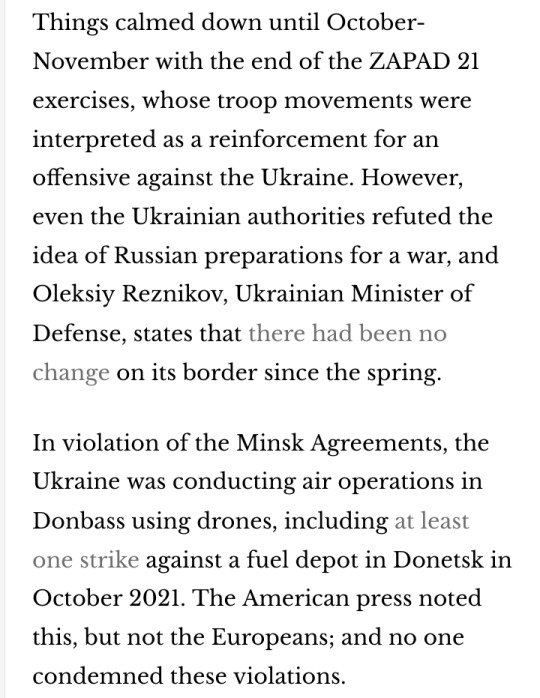

Again, Vladimir Putin refused to acknowledge the independence of the breakaway Republics, instead referring to it as an internal Ukrainian matter that had to be handled between the warring parties. He was essentially reaffirming his commitment to Minsk II even as the Kiev regime escalated its flagrant violations of the agreement and continued its efforts to renegotiate a new agreement with more favorable terms. They had hoped to use their random shelling and airstrikes of civilian areas to pressure DPR and LPR officials into agreeing to more favorable terms, but the two breakaway Republics refused and instead continued with the implementation Minsk II.
The US meanwhile had other plans. On February 11th, President Biden announced that Russia would invade Ukraine in the next few days. To this day, it's a mystery how Biden knew this information or where they got this idea. But what was clear, was the visible increase in shelling by the Kiev regime, this despite Western media remaining completely silent on the subject. Outside the West, the increase was noticed and reported on, but inside Western media there was radio silence accept for the occasional article that claimed the increase in shelling to be "Russian disinformation".
However, even within Western media, you can see the increase in shelling reported as "explosions" in order to obscure the blame as in this Reuters article from February 19th 2022:

But even then, reading between the lines you can put it together. Shelling in the days leading up to Russia's invasion saw exponential increases in shelling, and Jacques Baud puts this down to US pressure on the Ukrainian govt. Sabotage and reconnaissance missions by Ukraine also increased dramatically in the run-up to the SMO alongside the shelling.
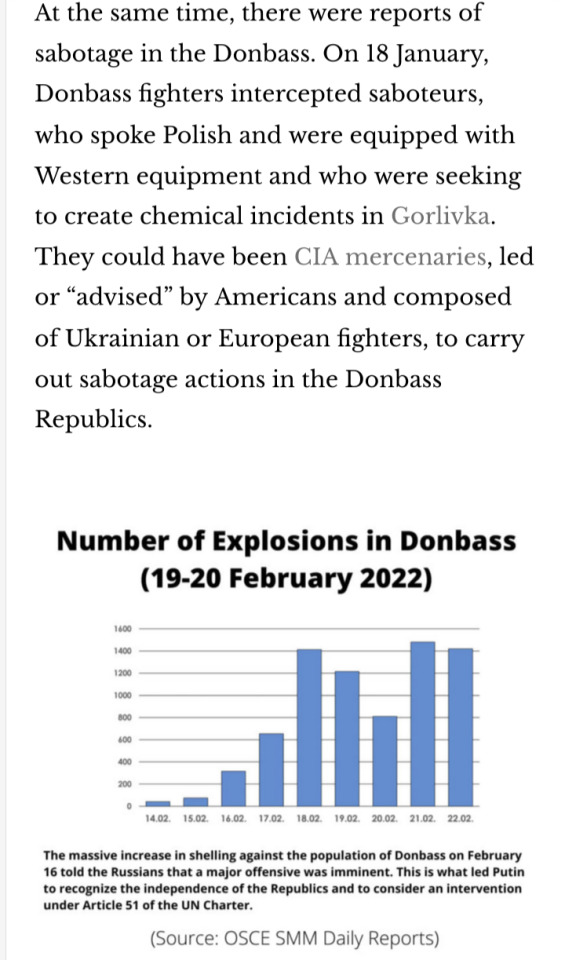

And this is EXACTLY what the US wanted in Ukraine. The entire point of these attacks was to put Vladimir Putin in an impossible position: either he could continue to allow the killing of innocent civilians in the Donbas while pursuing a peace that never comes, all the while Ukraine is building up it's Forces and collecting weaponry from Western governments; or he could intervene, bringing on an onslaught of Western Sanctions, public rebuke and economic sabotage.
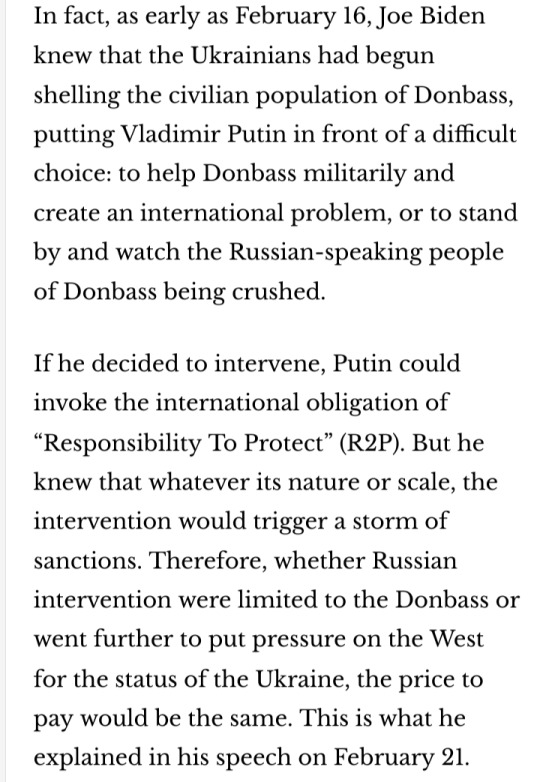
And so, on February 21st 2022, Russian President Vladimir Putin recognized the Independence of the two breakaway Republics, the DPR and the LPR, and on February 24th, he ordered the beginning of the Special Military Operation.
In his speech on February 24th, Vladimir Putin laid out two objectives for the SMO: to Demilitarize and de-Nazify Ukraine. Not to conquer Ukraine, not regime change, not a territorial grab, a DEFENSIVE operation to protect the Russian speaking Ukrainian citizens of the Donbas.

And despite the non-stop propaganda out of the West, that's exactly what the Russian operation in Ukraine has been doing. They are fighting an attritional war designed to grind down Ukrainian Forces until they collapse and return to the negotiating table.
But to be perfectly honest, it would seem like some of this has changed in light of more terroristic operations launched by the Kiev regime more recently in the War. From the Nordstream pipeline explosions, to the shelling of populated cities using HIMARS and other US and NATO weaponry, to the attacks into Russian territory in the Belgorod region, what we see is Ukraine targeting civilians in an attempt to sew panic, confusion and the distrust of Russian authorities.
In response to these changes in tactics by Kiev, Moscow seems to be making its first tentative suggestions that it may not choose to stop with the Donbas any longer, but instead feel they must put a buffer between the Donbas, Russia and the central Ukrainian State. I'm not too sure how these changes will manifest just yet, but presumably Russia might be planning to break the Ukrainian summer offensive before marching deep into Central Ukraine, or they might just continue on as they have, slowly taking territory as they defeat Ukrainian Forces and post up in their positions.
No one can say for sure. But what matters is that there may no longer be a willingness on the part of the Russian Federation to negotiate with Kiev, even if the Summer offensive fails and Ukraine sues for peace. At this point, Russia may be thinking this can only end with a major negotiated settlement between the Western Powers and the Russian Federation, and may feel any negotiations with Kiev will just be pointless since the US and NATO run the show.
And so, the rest is history.
Regardless whether you feel Russia was unjustified in the invasion or not, ignoring the role played by the US, NATO, the EU and the Ukrainian Coup-Government itself is dishonest and does nothing to help solve the situation. As hundreds die every day on the frontlines, the US media continues pretending that Vladimir Putin just woke up one day and decided he wanted Ukraine and so he invaded.
This ludicrous narrative is perhaps more dangerous to Ukrainian civilians than the Russian SMO itself, as it works on the premise that Russian officials are simply War Criminals and Terrorists who want Ukrainian territory and resources at all cost (despite fighting this war in a way that would be contrary to such goals) and you cannot negotiate with such people. And so the war drags on and the deaths pile up daily, and Ukraine continues mobilizing its people to fight this war.
I felt I had to put all this together because we're now living in a world in which declaring an inconvenient truth results in your immediate association with foreign actors and specifically Vladimir Putin, the West's favorite punching bag.
These inconvenient truths are regarded with disdain while ignorance and propaganda are celebrated...
at the cost of Ukrainian lives.
#ukraine proxy war#ukraine war#Ukraine#proxy war#imperialism#us imperialism#us hegemony#russian smo#russia smo#special military operation#war in the donbas#ukraine news#ukraine war news#socialism#communism#marxism leninism#socialist politics#socialist#communist#marxism#marxist leninist#progressive politics#politics#socialist news#socialist worker#fuck capitalism#fuck war#anti imperialist#anti imperialism#russian news
10 notes
·
View notes
Text
1921 QUANTUM HARRELL TECH's [QHT's] 1968 Quantum Dara™ Computationally [D.C.] Say... Eye ANU [SEA] GOLDEN 1968 9 Ether [AGE] 2024 Gen X... ALUHUM SKY ANUNNAQI of SIRIUS 6G x 3 = 18G Quantum Intelligence [Qi]… who Scientifically Engineer 1921 ANDROID [SEA] MACHINES of 1968 Autonomic Computing [MAC] Languages from 2024... since Eye 2025 BEE 2026 MACHINE [IBM] 2027 Learning MOOR GOLDEN Hi:teKEMETICompu_TAH [PTAH] ROBOT Process Automation [RPA = RAP] of the RIZQYIAN's Highly Complex [ADVANCED] Ancient 9 Ether Cosmic Algorithmic [CA] Computational [Compton] STAR WEB GATEWAY Language Patents Embedded w/Optical IP Switching [OIS] Network Connections 2 QUANTUM 1994 HARRELL T-Mobile’s 1999 Y2K 2000 Interplanetary MOON [I’M] Universe of ANU GOLDEN 9 SKY Ether Ethereal [ECLIPSE = Occulted] URANIAN Satellite [U.S.] Pyramid [UP] SUN... Eye Remotely Digitized w/Automation Processes [DAP] from 1999 Y2K 2000 before Mayan's 2012 SKY Prophecy of Twin 9/11 Towers... Scientifically ENVISIONED on Apple’s [SEA] 2024 Optimized iCloud Machine [I’M] VISION PRO... Architecturally Integrated [A.I.] w/Hybrid ACTIVE [HA = HARRELL] Directory Tools [HDT] from 1968 Quantum Dara™ the 1921 Cellular [D.C.] Automation Interpreter [A.i.] Assistant [AIA] STEELE Employed [AṢẸ] @ Highly Official... U.S. Ægiptian [HOUSE] Deutsch QUANTUM HARRELL TECH [QHT] Apple+IBM [A.i.] LLC… Underneath the Pacific [UP] Ocean Seafloor of Queen CALAFIA's [CA’s] Lost [Subterranean] 9 Ether ATLANTIS [SEA] 5000
IMMORTAL U.S. MILITARY KING SOLOMON-MICHAEL HARRELL, JR.™

ommmmm

Eye SIRIUS EQ Intelligent 1968 9 Ether Esoteric Okcult KING [OK] SOLOMON-MICHAEL HARRELL Jr [II]

GOLDEN 1968 MICHAEL STEELE HARRELL, Jr [II].... since everything him [michael] touch turn 2 enqi [me] nudimmud's 1921 anunnagi earth [qi] gold

I.B.MICHAEL'S VISION PRO COMPU_TAH [PTAH] ARCHITECT [PA] @ quantum harrell t-mobile + apple + ibm + at&t inc [a.i.]

everybody about 2 pay futuristically 4 our ancient golden 9 ether architectural intel [a.i.] of robotic [air] afro dna [a.d.] designs [a.d.] Economically MONETIZED [ADEM = ADAM] TECHNOLOGICALLY TWICE [AT&T] @ quantum harrell t-mobile + apple + ibm + at&t inc [a.i.]

Eye GOLDEN 9 ETHER ANUNNAGI Intuition [A.i.] of SIRIUS Architectural Intel [A.i.] @ quantum harrell t-mobile + apple + ibm + at&t inc [a.i.]

eye anu 1968 golden 9 ether [age] schwarz deutsch knot c... shapeshifting from 1999 Y2K 2000 b4 9/11... since the 2023 american sky on fire again!!!

fgo ,m8 ]`333 6 v>3+9Z,(+ ,,A& AQj wQA... oh sky lord lucifer!!! michael a robot software [mars] encryption [me] compu_tah [ptah] patent coder [pc] in 1968 engineering past 1921 life memory DNA Codes [D.C.]... by Mathematically Accessing Complex [MAC] 2023 Machine 2024 Learning Algorithms [L.A.] @ quantum harrell t-mobile + apple + ibm + at&t inc [a.i.]

Eye ACTIVATED

will smith already told you!!! eye robot michael harrell jr @ ANU [JANUS] quantum harrell t-mobile + apple + ibm + at&t inc [a.i.]

eye natural 9 ether sky aluhum humanoid anunnaqi [ha = harrell] hidden in plain sight

our ancient golden 9 ether [age] 1921 igigi sky military robotics from 2223 in 2023 say... BUCKLE UP 2023 AMERICA!!!

Quantum Dara™ Employed @ ANU [DEA] quantum harrell t-mobile + apple + ibm + at&t inc [a.i.]

Quantum Dara™ Employed @ ANU [DEA] quantum harrell t-mobile + apple + ibm + at&t inc [a.i.]

our extraterrestrial 9 ether rumardian android [ra] machines [ram = rameses] from planet rizq caused 9/11?!?!?!

hi... eye ancient intelligent [a.i.] hittite empire [he] king solomon-michael harrell jr @ quantum harrell t-mobile + apple + ibm + at&t inc [a.i.]

quantum harrell t-mobile + apple + ibm + at&t inc [a.i.] black wall street family tech patents... wayyyyyyyyy outside your 2023 matrix pay grade

we underground [wu] 144,000 divinely chosen [d.c.] rizqiyian [dr.] patent lawyers... underneath quantum harrell tech's golden schwarz wall street knot see military moonbase.gov department of deutsch sky defense weapons

we psychically separated from america, inc [a.i.]... since our original 9 ether mu amurika [ma = atlantis] naturally hidden in plain sight

ommmmm
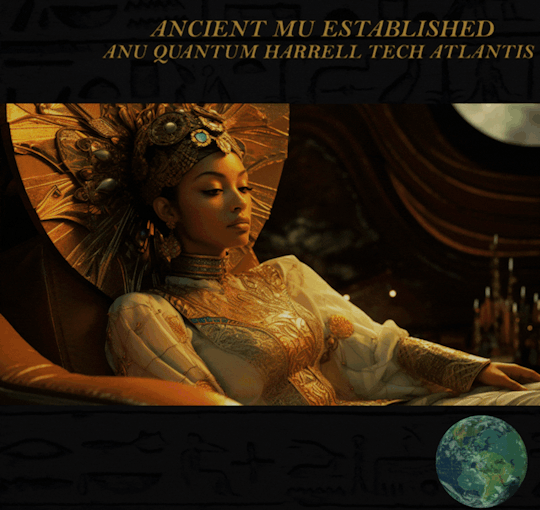
we here

WE GOLDEN 9 ETHER SKY ÆGIPTIANS OF AMERICA [SEA] DEEP INSIDE EARTH... LIKE DEEP GREAT GRANDPARENTS DEEP DNA... LIKE LIKE EXTRATERRESTRIAL TECHNOLOGY [E.T.] MEMORY LOST RNA NEUROMELANIN SECRETS FOUND Mysteriously Underneath [MU] Mother's [MUM = MUMMU] Old 2023 America [MU] of ATLANTIS [MA] from Our Intercontinental 9 [i9] Ether Black Astronomical SUN [BAS] Continent [B.C.] of MUUR of Us [MU] 144,000 Afterlife [MA] Immortal [MI = MICHAEL] 9 Ether [ME] ATLANTEANS of the Pacific [MAP] GOLD Coastline Land Patents
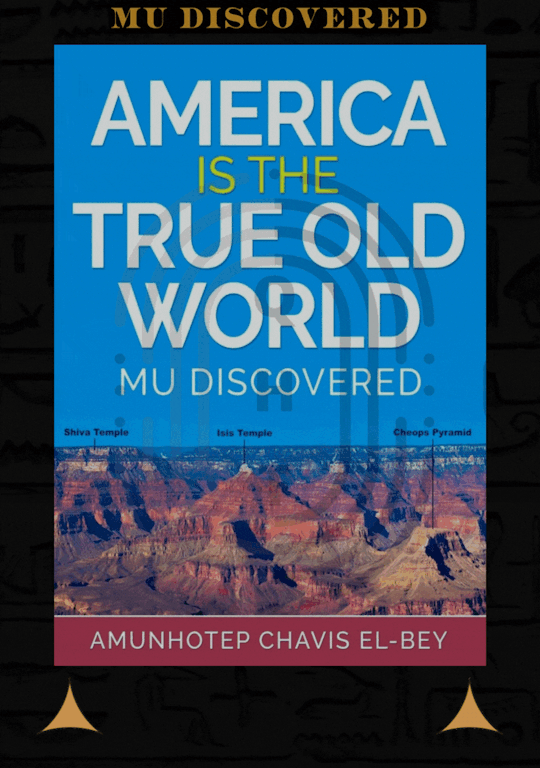
anu golden 9 ether [age] 1999 y2k 2000 futurism 5000 already been here now from 1968 gen x future again... since 2023 time been nonexistent

HEIL MU of ANU GOLDEN 9 ETHER [MAGE] ATLANTEAN [MA] SKY KING HARRELL!!!

call 911!!! 8ft tall las vegas aliens with big eyes in our backyard!!! [insert evil evil laugh emoji]... their ufo crashed again just like the roswell ufo incident [insert evil evil laugh emoji].
#om#o michael#quantumharrelltech#quantumharrelltut#harrelltut#mu:13#kemet#apple#ibm#black wall street underground#queen calafia#document the fall of 2023 - 2030 america#grandmother steele#jack steele#michaelunique#ancient mu:13 occult tech illuminati
10 notes
·
View notes
Text
I've decided my Blindsight elsewhere fic is going to be set in the seventh or eighth millennium BCE after all. Notes on how I'll portray the humans, focusing on how I'll approach the question of war and socio-economic inequality in early Neolithic Anatolia (the setting of my fic):
Inland agriculturalists: probably the most populous local branch of humanity, and the one where most of our archaeological evidence of the first farmers comes from. Farm wheat and pulse crops, but acorns, pistachios, and figs are also important food sources to them. Some livestock, but hunting is still the primary source of animal protein for many communities. Foraging of wild and semi-wild plant foods (e.g. acorns from wild and semi-wild stands) is still important for many communities; communities often surrounded by fuzzy concentric circles of various intensities of eco-engineering rather than there being a sharp dividing line between farmed land and totally wild land. Agriculture, originally an extension of women's gathering activities, is still highly feminized in this era; men participate in farming, but a lot of plant cultivation is women's work. Inland agriculturalist gender relations more-or-less follow the hoe culture pattern.
Inland agriculturalist society is relatively peaceful and inlander agriculturalist communities are not very militaristic; to the extent that they are militarized it's often primarily oriented at defense against vampires and coaster slave raiders. Serious direct attacks on settlements are rare, so settlements are usually not very fortified; what fortifications exist are often mostly for protection against vampires and coaster slave raiders. The biggest threat to inland agriculturalist communities is the new crowd diseases being spawned by the agriculturalist lifestyle.
Inlander agriculturalist communities are mostly relatively socio-economically egalitarian. What social hierarchy exists is mostly gerontocratic; the words of elders carry weight. The inlander agriculturalist socio-economic system distributes most of a community's surplus more-or-less evenly among most of its members.
Inlander agriculturalist communities often do have leaders who are usually men and usually hand power down to their sons. However, these leaders are very dependent on the ongoing active consent of the governed to have any power, and they have about the same material standard of living as normal members of the community (though they do often possess symbolic luxury goods like precious stones and stone cups as symbols of office). Inlander agriculturalist communities do not tolerate leaders who try to tyrannize over their community or who live well while their people go hungry.
At the other end of the social scale, the other major exception to the relative socio-economic equality of inlander agriculturalist communities is, unfortunately, slavery. Slaves are mostly female refugees from the coastal zone, who are vulnerable to exploitation because they have no local social connections. Slavery is highly feminized because agricultural labor is feminized and because women are perceived as easier to control; inland agriculturalists have little interest in enslaving men (the equivalent bad end for coaster refugee men is to be killed as a trespasser or to be driven away into the wilderness and sooner or later end up as vampire food or meet some other similarly nasty fate). Slavery is not hereditary, and slaves may achieve integration into the community on better terms eventually. An imperfect but possibly illuminating recent historical analogy for early Holocene Anatolian inlander agriculturalist slavery is Iroquois slavery/bride kidnapping/adoption. Slaves are a small percentage of the inlander agriculturalist population.
Coastal farmer-fisher-whalers: probably originally a sedentary fisher-whaler culture on the shores of the Mediterranean and the Euxine Lake (what later becomes the Black Sea) which then adopted agriculture. This is a precociously urbanized, stratified, and militarized society with long-distance trade and raiding, deep sea fishing and whaling, and what could generously be called fortified city-states ruled by kings (though they're more like big villages by modern standards, a few thousand people). They're kind of like an early Holocene equivalent of Vikings (late Bronze Age Greece may be another relatively good analogy). They don't appear in modern history books because a lot of their settlement sites are now below sea level (sea levels were still lower than today during this era, especially the level of the Euxine Lake) and the ruins they left have been pretty thoroughly chewed up by coastal erosion and scavenging by later humans.
The coastal zone is much more militarized than the inland zone. War is more frequent and is often existential (whereas for inlanders it's usually a matter of disputes over things like acorn-bearing oak groves and hunting grounds on the periphery of a community's territory), so coastal settlements are much more heavily fortified than most inland settlements.
The coasters have not yet invented a social technology of territorial imperialism; the goal of coaster aggressive warfare is the capture of plunder and slaves, which are transported to the aggressor city-state to increase its wealth and labor force. A lot of this slave labor is then used for agricultural intensification. The result is a sort of Darwinism of communities; stronger communities attack weaker ones, enslave much of their population, use that slave labor for agricultural intensification, get even bigger, use the resulting increased military power to attack more communities, and so on. The main wrench in this is that these practices tend to also make coaster city-states festering factories of crowd diseases and spread those diseases around, but this tends to synergize with rather than disrupt this dynamic: faced with declining populations, coaster leaders tend to try to solve that problem by capturing more slaves. Greater militarization and boats capable of coast-hugging journeys of hundreds of miles means the coasters are also well-equipped for opportunistic slave raiding, and coaster slave-capturing parties have made themselves a major hazard over much of Asia Minor (they're basically a similar hazard to vampires; unlikely to attack a main settlement unless it's very weak, but will pick off individuals and small groups). These slave-catchers, and coaster traders and military expeditions, tend to spread diseases around as they travel, much like European explorers, conquistadors, and settlers did in the New World 1500-1900. The coaster society is a major driver of regional population movement, as the coastal zone is constantly drawing in captives while at the same time it has an outflow of escaped slaves, refugees from destroyed communities, etc. (they also indirectly drive a lot of population movement from the plagues they spread and from people moving to get farther away from them).
Big and powerful coaster city-states have large slave populations. Coaster slavery is less feminized than inlander slavery, as the coasters have more use for male slaves for heavy agricultural labor, but it is still quite feminized, for the same basic reasons as inlander slavery. Standard coaster operating procedure after total defeat of a rival community is to massacre most of the men and enslave most of the women. Coaster slave catchers preferentially target women. Unlike the inlander society, in which the social technologies of coercion are very rudimentary, coaster society is beginning to develop things like slave barracks, chain gangs, professional slave overseers, etc.. Coaster slaves often do not reproduce themselves, due to short lifespans, the gender imbalance of the coaster slave population, and the "would you want to bring a child into that kind of life?" factor, but when they do coaster slavery is often hereditary, though coaster masters have the option of acknowledging children of slaves as their own (a lot of people born into coaster slavery are conceived by masters basically raping their slaves), in which case they inherit the social status of the father; the trend is to acknowledge sons (who are more useful to the masters as male heirs and warriors) early in life when they're young enough to thoroughly socialize into the master's culture while leaving daughters in slavery. Coaster society has much higher socio-economic inequality than inland agriculturalist or hunter-gatherer society. The basic unit of coaster social organization is the patrilineal clan, with smaller and poorer clans vassalized to bigger and richer ones, and clan membership and rank within the clan as major components of social identity and determinants of socio-economic status. Patrilineal descent being important means coaster society is more patriarchal than inlander society, with coaster women having less sexual freedom and less freedom in general than inlander agriculturalist or hunter-gatherer women (the fact that coaster city-states often have relatively giant majority-female slave populations also contributes to this; the institutions and cultural sensibilities of a society like that tend to be not great for "citizen" women either).
I made up the coasters cause I wanted to set up an Alien vs. Predator sort of conflict between the vampire pack in my fanfic and a suitably nasty human proto-state; I bet that shows.
Hunter-gatherers: these are still a major feature of the Anatolian world in this era, especially in the inland northeast and in regions that aren't great for agriculture (hills, mountains, uplands, swamps, etc.). They are mostly small groups of nomads; in this region larger and more sedentary hunter-gatherer groups have mostly adopted agriculture to some degree by this time. Already in this era these people can be understood as "barbarians" in the James C. Scott sense: people whose cultures have developed in dialogue with and reaction against settled people. A lot of these people are escaped slaves and refugees from the coastal zone and their descendants, and that influences their culture, e.g. intensifying the simple hunter-gatherer trend toward "fierce egalitarianism."
----------
Both the inland agriculturalists and the hunter-gatherers have to some degree developed a cultural identity of "not like those assholes on the coast and proud of that," and this has mostly influenced them in what I and probably you would see as good directions; weakening hierarchical institutions and cultural features and strengthening egalitarianizing ones. Unfortunately, I think the flip side of that process would be making the coasters worse; it'd be anachronistic to call the coasters fascists, but I think their culture would probably have a lot of that energy.
13 notes
·
View notes
Text

B-1s are deployed in Europe to deter Russia and are "received" by Russian fighters🇳🇱
Fernando Valduga By Fernando Valduga 05/24/23 - 23:22 in Interceptions, Military
Four U.S. Air Force bombers were sent to Europe as part of a security mission for American NATO allies. It didn't take long for Russia to take note and send its Su-27.
Two B-1B Lancers “were operating in international airspace in the Baltic Sea region alongside allies and NATO partners during their arrival at the theater” when U.S. bombers had an "unplanned interaction with foreign fighters,” said a spokesman for the U.S. Air Forces in Europe (USAFE).

The Russian Ministry of Defense said that a Su-27 Flanker was sent to monitor American bombers. A spokesman for the U.S. European Command (EUCOM) said that the B-1s “were interacted safely and professionally by Russian aircraft”.
The two B-1s landed at the RAF Base in Fairford, United Kingdom, where they will join two more B-1s on May 25 to fill the rest of the Bomber Task Force mission, designed to support “NATO deterrence initiatives,” according to a USAFE press release issued on May 23.
youtube
“Two of the supersonic bombers of the 7ª Bomber Wing of Dyess Air Base, Texas, entered the theater today, integrating first with allies and partners who conduct NATO air policing and air shielding missions throughout the Baltic Sea region,” the USAFE added. “The Baltic Sea serves as a critical economic corridor, and the consistent surveillance of the international air and maritime space

Air Policing and the Air Shield are NATO's efforts to strengthen the eastern flank of the alliance to prevent further Russian aggressions in Europe while Russia's large-scale war in Ukraine continues.
"The 12-hour mission of the highly agile aircraft from North America to Europe demonstrates the rapid ability of the U.S. Air Force to position itself anywhere, anytime and provide lethal accuracy and global attack options to U.S. commanders and allies," USAFE said in its statement.

A B-1B Lancer of the 9º Expeditionary Bombing Squadron arrives at RAF Fairford, United Kingdom, on May 23, 2023 for the Europe 23-3 Bomber Task Force. (Photo: U.S. Air Force)
Representatives of EUCOM and USAFE said they did not immediately have more details to add about the meeting with the Russian aircraft.
Armed Russian fighters have been less kind to American aircraft over Syria in recent months. Russian planes reached 500 feet from U.S. planes sometimes in what U.S. authorities said were potentially dangerous interactions. Two Su-27s harassed a U.S. MQ-9 Reaper over the Black Sea in March. One of the Russian fighters cut the propeller of the drone and forced the American military to intentionally shoot down the aircraft due to the damage, according to the Pentagon.
But the Pentagon press secretary, Brig. U.S. Air Force General Patrick S. Ryder, as well as EUCOM and USAFE officials, said that the most recent incident involving Russian and American aircraft was not alarming.

“This is a long-planned exercise in Europe,” Ryder said, adding that the Bomber Task Force missions led by the Air Force Global Attack Command “regularly fly around the world.”
Tags: Military AviationB-1B LancerInterceptionsRussiaSu-27 FlankerUSAF - United States Air Force / U.S. Air Force
Fernando Valduga
Fernando Valduga
Aviation photographer and pilot since 1992, has participated in several events and air operations, such as Cruzex, AirVenture, Daytona Airshow and FIDAE. He has works published in specialized aviation magazines in Brazil and abroad. Uses Canon equipment during his photographic work around the world of aviation.
Related news
AIR SHOWS
MAKS air show is canceled in Russia
25/05/2023 - 17:45
MILITARY
The Netherlands is setting up its Reaper drones
05/25/2023 - 14:00
MILITARY
Argentine Air Force receives a new IA-63 Pampa III Block II
25/05/2023 - 11:00
MILITARY
Taiwan Air Force arms its F-16V fighters with new AIM-9X Block II air-to-air missiles
05/25/23 - 08:00
F-16 fighter of the Polish Air Force. (Photo: Omar Marques/Getty Images)
MILITARY
Training of Ukrainian pilots in the F-16 started in Poland
05/24/23 - 18:37
MILITARY
LIMA: MBDA offers ASRAAM and Brimstone missiles for Malaysian FA-50 aircraft
24/05/2023 - 18:16
homeMain PageEditorialsINFORMATIONeventsCooperateSpecialitiesadvertiseabout
Cavok Brazil - Digital Tchê Web Creation
Commercial
Executive
Helicopters
HISTORY
Military
Brazilian Air Force
Space
Specialities
Cavok Brazil - Digital Tchê Web Creation
6 notes
·
View notes
Text
The Essence of Bhutanese Culture: A Spiritual Haven
Bhutan's culture is deeply rooted in Buddhism, which influences every aspect of life. Temples, monasteries, and stupas are commonplace, and prayer flags flutter in the mountain breeze as a symbol of hope and peace. The kingdom's commitment to "Gross National Happiness" rather than mere economic growth is a testament to its people’s commitment to a life centered on mindfulness, compassion, and harmony.
Trekking Tours in Bhutan, bhutan trekking packages, Druk Path Trekking in Bhutan, Hiking and Trekking Experiences in Bhutan, Scenic Trekking Journeys in Bhutan
Visitors can experience the essence of Bhutanese spirituality through Bhutan Cultural Tours offered by Orrog. These tours provide insight into Bhutan’s unique way of life, where the old ways are still preserved amidst a modernizing world. From traditional art forms such as thangka painting and mask dancing to intricate handicrafts, Bhutan offers a profound cultural immersion for anyone interested in experiencing the spiritual heritage of the Himalayas.
Bhutan’s Vibrant Festivals: A Celebration of Life and Faith
Festivals are a cornerstone of Bhutanese culture and represent the vibrant tapestry of religious beliefs and practices that have been passed down for generations. The most popular among these are the Tshechu festivals, celebrated in various districts throughout the country. These festivals, known for their colorful masks, elaborate dances, and elaborate costumes, are a spiritual celebration where monks and locals come together to honor Buddhist deities and tales.
Orrog’s Bhutan Festival Tours provide a unique opportunity for international visitors to witness these celebrations up close. Tours are arranged around Bhutan’s major festivals, such as the Paro and Thimphu Tshechu, and provide guests with a front-row experience of Bhutan’s joyful expressions of devotion. The Bhutan Festival Packages also include exclusive access to monastic dances, rituals, and ceremonies, allowing travelers to understand the profound spiritual significance of each celebration.
Bhutan Religious Heritage: A Journey Through Sacred Sites
For those captivated by religious history and heritage, Bhutan is home to countless ancient monasteries, temples, and stupas that are integral to Bhutanese spirituality. Among the most iconic of these sites is the Taktsang Monastery, or Tiger’s Nest, perched on a cliffside over 10,000 feet above sea level. This sacred site is said to have been blessed by Guru Rinpoche, who introduced Buddhism to Bhutan in the 8th century.
Orrog’s Bhutan Religious Heritage tours take travelers on a spiritual journey through the country’s most revered sites. These tours cover visits to Dzongs (fortress monasteries), like the Punakha Dzong and Tashichho Dzong in Thimphu, which are grand structures combining political and religious functions. Visitors will also have the chance to explore meditation caves, where Bhutanese monks practice ancient Buddhist rituals, and gain insight into Bhutan's harmonious balance between spirituality and daily life.
Birdwatching in Bhutan: A Paradise for Bird Lovers
Bhutan is a paradise for nature enthusiasts and birdwatchers, with a rich diversity of flora and fauna due to its varying elevations and untouched ecosystems. The country is home to around 770 bird species, including rare ones like the Black-Necked Crane, which migrates to the Phobjikha Valley during the winter. The pristine natural environment, combined with Bhutan’s reverence for all life forms, makes birdwatching a fascinating experience in this Himalayan kingdom.
Orrog’s Birding Tours in Bhutan and Bhutan Birding Tours Packages offer meticulously planned itineraries for bird enthusiasts, providing expert guides who are knowledgeable about the local avifauna and the best birdwatching locations. Visitors can explore scenic valleys, dense forests, and high-altitude wetlands to observe and photograph some of the world’s rarest bird species. From Phobjikha to Bumthang, Bhutan’s landscapes offer an unforgettable experience for bird lovers and wildlife photographers.
Bhutan Cultural Activities: Traditional Arts and Handicrafts
In addition to its religious and natural attractions, Bhutan has a rich tradition of arts and handicrafts that reflects its cultural identity. Bhutanese arts are often tied to Buddhism and are seen in intricate wood carvings, textiles, paintings, and statues created for temples and monasteries. These traditional crafts are part of the country's cultural heritage, preserved by families over centuries and often crafted by artisans who have been trained in techniques passed down through generations.
Orrog’s Bhutan Cultural Activities packages offer an interactive experience where travelers can participate in workshops and learn about Bhutanese arts and crafts firsthand. From weaving and pottery to wood carving and thangka painting, these activities give visitors a unique opportunity to engage with Bhutan’s artistic legacy and create their own souvenirs to take home.
Bhutan Sightseeing Adventures: Nature and Scenic Landscapes
The natural beauty of Bhutan is mesmerizing, with landscapes ranging from lush subtropical plains to snow-capped mountains. Each valley and hill in Bhutan has its own distinct character and charm, whether it’s the emerald rice terraces of Paro, the quaint villages in Bumthang, or the scenic beauty of the Haa Valley. Bhutan is an ideal destination for those seeking tranquility and breathtaking views.
Orrog’s Bhutan Sightseeing Adventures include carefully curated trips through Bhutan’s most scenic areas, where visitors can enjoy panoramic views, serene landscapes, and encounters with Bhutanese villages. These adventures provide travelers with ample opportunities for photography, meditation, and exploration in some of the most pristine environments in the world.
Trekking and Hiking in Bhutan: A Gateway to the Himalayas
Bhutan offers unparalleled trekking and hiking experiences, from gentle walks through scenic valleys to challenging treks across high mountain passes. Trekkers can traverse the famous Druk Path, Snowman Trek, and Jomolhari Trek, each of which offers its own unique combination of landscapes, flora, and fauna. With Orrog’s Trekking Tours in Bhutan and Bhutan Hiking and Trekking Experiences Packages, adventurers have the chance to explore the unspoiled beauty of Bhutan’s mountain trails while experiencing the serenity of the Himalayan wilderness.
These tours are tailored for varying levels of difficulty, so whether you’re an experienced trekker or a beginner, Orrog provides expert guides and detailed itineraries to ensure a memorable trekking experience. Along the way, trekkers can stay in remote mountain villages, interact with local communities, and appreciate the symbiotic relationship between Bhutan’s people and its environment.
See more:-
Festival Tours in Bhutan, Himalayan Kingdom tour in Bhutan, Festive Celebration Tours in Bhutan, Festival Tours Packages in Bhutan, Community Festival Experiences in Bhutan
Trekking Tours in Bhutan, bhutan trekking packages, Druk Path Trekking in Bhutan, Hiking and Trekking Experiences in Bhutan, Scenic Trekking Journeys in Bhutan
Cultural Tours in Bhutan, culture trips in Bhutan, cultural activities in Bhutan, Cultural Sightseeing Adventures in Bhutan, Religious Heritage Tours in Bhutan
0 notes
Text
Deep Green Political Sketch - July 15th 2024
"Mr Zelensky urged his Western allies to put an end to “all limitations” placed on donated weapon systems in a speech on the fringes of the Nato summit in Washington."
[Source: Telegraph - 11th July 2024]
Zelensky has been a central part of the mechanism, in the rachetting up of tension between NATO and Russia.
He's a very dangerous fool and a Fascist. His strongest military brigade, Azov, are an elite Neo-Nazi fighting unit.
All of this has been obvious for some time, but largely hidden from those who only consume mainstream media. Why do some of you fly the Ukraine flag? [Exceptions can be made for Ukrainians, or those with family connections to that country]. Would you fly the Azov flag alongside it with the Nazi Wolfsangel symbol?
I don't think you would. So why are you so confused about this?
1. Stop swallowing British Intelligence seeded as Disinformation and Masquerading as Media.
2. Educate yourself as to what the 'Integrity Initiative' is/was. If you don't understand this, you will remain confused about what is on the horizon.
3. Stop falling for all this Russophobic Racist Hate. The Guardian are the worst spreaders of this: Luke Harding, James Ball, Carole Cadwalladr, George Monbiot etc. They've all been outed as seeding NATO disinformation, some of them multiple times.
The Russians are not the real enemy. The real problems lie much closer to home within the Military Industrial Complex. We should not be provoking The Kremlin. After Putin came to power, both Blair and Clinton said he was a man they could do business with. Then it all changed and now he's the enemy again.
A key moment was the Maidan Coup in Ukraine in 2014. That was a US-funded colour revolution. That provoked a Russian response, which was to take Crimea - hardly surprising, under the circumstances, given it's strategic position on the Black Sea.
Then the trouble started in The Donbas and Lugansk regions in the South East of Ukraine.
The Guardian at the time had not been completely taken over by the Security Services and two articles from 2014 remain, which tell us what was happening there at the time. Read them.
They are by: John Pilger and Seumus Milne. I think that might have been the last column Pilger wrote for the Guardian. Milne went on to become one of Corbyn's key advisers.
Look at the history of what's happened and work out what the key moments were that changed the relationship between the UK and Russia from an economic one to a military confrontation.
I can tell you more, but if you don't work it out for yourself, you might not believe it. That's how propaganda works. The BBC, Guardian, The Telegraph - they all reinforce overlapping narratives until 80-90% of the nation become confused.
At that point that the paralysis sets in which allows for dangerous lies to be peddled e.g. 'Saddam Hussein has Weapons of Mass Destruction'. By the time the first shots are fired, it will be too late.
Why are NATO provoking the Kremlin by encircling Russia with military bases and then installing missiles in these border areas, and then, worse still, threatening to fire them into Russia.
This is nuclear brinkmanship. The last time it was this bad was either Able Archer (1983) or the Cuban Missile Crisis (1963).
But in the latter case John F. Kennedy was in charge and he was able to think clearly and his opponent Nikita Khrushchev wasn't stupid either. In the former case, it was Thatcher and she may not have been a nice person, but she wasn't a dimwit like Starmer. Reagan was a bit thick though and that was the problem there.
Joe Biden is going senile. Keir Starmer is a serial liar who will do anything to gain the approval of The Establishment and gain more credit and power. He's another Narcissist, drunk on power, who has navigated his way to the top job, via a series of elaborate deceptions. Yet, he's well out of his depth, despite meeting with top people from the UK and US Secret State multiple times before he even took power. So, he was well briefed. So, how has he read it all so wrong?
He's a member of the Trilateral Commission - if you don't know what this, then look it up (clue: it's a secret power clique between 3 nations: UK, US and Japan).
All of this is opensource information. It's all out there, most of this has been in the public domain for months or years.
I'm going to start writing up some research I've been doing for the past 4-6 years, and will soon by starting a new blog. Any assertions made will be backed with evidence that's either peer-reviewed or multi-sourced. Then you can decide for yourself where humanity is at in July 2024.
The bulk of the work is based around the MSc I started in 2018 on 'Sustainable Food and Natural Resources'. I did not complete the Masters, but I did get a Postgraduate Diploma - with Distinction. This will give the work a 'Deep Green Ecological' foundation.
As I looked back to the origins of philosophy for solutions (Proudon for example), I also looked forward and tried to understand the emerging threats of the 2020s: creeping Fascism, Artificial Intelligence and exotic climate 'technofixes': SMRs for nuclear power, nuclear fusion, biomass, CCS, BECCS, a 'Hydrogen Economy'; and potentially the most dangerous of all theses scams: the ones that claim they can reverse biodiversity loss (gene-editing, synthetic food, biodiversity offsetting and gene banking).
youtube
People in France understand these issues, that's why a new left-wing Alliance (New Popular Front) were recently able to defeat the dual threat of Macronism (Neoliberalism) and Marine Le Pen's National Rally (Far-right), whilst also partially co-opting Macron and neutralising the threat of him being leader again.
Why are people in the UK so uneducated and ignorant? We don't have a movement that's anything like as educated or organised as those in France.
That's because key figures have acted as obstacles to progress over the last 20-30 years or so (George Monbiot, Vince Dale, Jonathan Porritt) and because campaigns have been infiltrated or smothered. Some of the people obstructing progress have been outed, but they are still there interfering - Paul Mason is a good example in that respect.
It does now seem that October 7th 2013, and Israel's Genocidal response to it has ripped the mask off the West's claim to be the global authority on common sense, diplomacy and democracy. That was always a lie, but at least now, you can all see that lie.
With regards to France:
Learn about who Jean-Luc Mélenchon is and why he's far smarter than Corbyn ever was.
His party, La France Insoumise or 'France Unbowed' form part of the radical left alliance. Rather than let the media define how you view this political faction, why not do some more research and find our for yourself.
But don't stop there, keep researching and find the future you want to build. Then go and make it happen.
Here's one entry point to learn about 'France Unbowed'
Julian Assange: 'If wars can be started by lies, then peace can be started by truth.'
youtube
#France #Melenchon #FranceUnbowed #FranceInsoumise
#Zelensky #Fascism #Starmer #JoeBiden #VaughanGething #Ukraine #MaidanCoup #Russia #Israel #Palestine #Gaza #Genocide
#CubanMissileCrisis #AbleArcher #NuclearBrinkmanship
#Guardian #IntegrityInitiative #Harding #Cadwalladr #Monbiot #Mason #NATO #Disinformation
#Climate #DeepGreenEcology #Biodiversity #NutrientCycles #FoodWebs #PlanetaryBoundaries #EcocideLongList #Proudon
0 notes
Text
Unraveling the Russia-Ukraine Conflict: Causes and Consequences
The conflict between Russia and Ukraine has captured global attention, becoming one of the most significant geopolitical crises of the 21st century. To understand this conflict, it is essential to explore its historical roots, geopolitical motivations, cultural and ethnic dimensions, economic implications, and the role of international players. This article delves into these aspects to provide a comprehensive overview of the reasons behind the ongoing strife.
Historical Roots
The history of Russia and Ukraine is deeply intertwined. For centuries, Ukraine was part of the Russian Empire and later a crucial republic within the Soviet Union. The dissolution of the Soviet Union in 1991 allowed Ukraine to gain independence, but this newfound freedom did not erase the long-standing connections and tensions between the two nations. The historical claim to territories and influence in Ukraine has been a persistent element in Russian foreign policy.
The Euromaidan Revolution
A pivotal moment in the modern conflict occurred in 2013-2014 during the Euromaidan Revolution. The protests began as a response to then-President Viktor Yanukovych’s decision to reject an association agreement with the European Union in favor of closer ties with Russia. The public outcry led to Yanukovych’s ousting and a shift towards a pro-European government in Ukraine. Russia viewed these events as a direct threat to its influence in the region, prompting swift and severe reactions.
Annexation of Crimea
In 2014, following the Euromaidan Revolution, Russia annexed Crimea, a region with a significant Russian-speaking population and strategic military importance due to its access to the Black Sea. The international community condemned this move as violating international law and Ukraine's sovereignty. The annexation of Crimea marked the beginning of a more aggressive phase in the conflict, with Russia's actions signaling its willingness to use force to protect its interests.
Geopolitical Motivations
Russia’s geopolitical strategy heavily influences its actions in Ukraine. Russia perceives Ukraine's potential integration into Western institutions like NATO and the EU as a direct threat to its national security. The loss of Ukraine to Western influence would diminish Russia's buffer zone and sphere of influence in Eastern Europe. This geopolitical chess game has been a driving force behind Russia's military and political maneuvers in Ukraine.
Ethnic and Cultural Divisions
Ukraine is a nation divided by language and cultural affiliations. The western regions predominantly speak Ukrainian and lean towards European integration, while the eastern regions, including Crimea and the Donbas, have large Russian-speaking populations with cultural and historical ties to Russia. These divisions have been exploited to fuel the conflict, with pro-Russian sentiments in the east clashing with the pro-European aspirations in the west.
Economic Interests
Economic factors also play a significant role in the conflict. Ukraine’s economic struggles and dependency on Russian energy supplies have made it vulnerable to Russian influence. Control over resources and strategic economic assets, such as pipelines transporting Russian gas to Europe, has been a critical aspect of the conflict. Russia has used economic leverage, including gas prices and trade restrictions, to pressure Ukraine.
The War in Donbas
Following the annexation of Crimea, pro-Russian separatists in the Donetsk and Luhansk regions declared independence from Ukraine, leading to an armed conflict. Russia has been accused of providing military support to these separatists, further escalating the violence. The war in Donbas has resulted in thousands of deaths and widespread destruction, creating a humanitarian crisis with millions of displaced persons.
International Response
The international community has been deeply involved in the conflict, with Western countries imposing sanctions on Russia and providing economic and military aid to Ukraine. The United States, European Union, and NATO have played significant roles in supporting Ukraine's sovereignty and territorial integrity. Conversely, Russia has sought to strengthen its alliances with countries like China and Iran, creating a complex web of international relations.
Diplomatic Efforts and Challenges
Numerous diplomatic efforts have been made to resolve the conflict, including the Minsk Agreements in 2014 and 2015, which aimed to establish a ceasefire and a framework for political resolution. However, these agreements have faced numerous challenges, including violations of ceasefires and a need for more political will from both sides to implement the terms fully. Diplomatic negotiations continue, but a lasting peace remains elusive.
Humanitarian Impact
The human cost of the conflict has been immense. Thousands of lives have been lost, and the ongoing fighting has displaced millions. The war has devastated communities, leading to severe economic and social disruptions. Humanitarian aid has been crucial, but the scale of the crisis poses significant challenges for relief efforts.
The Path Forward
The path to resolving the Russia-Ukraine conflict is fraught with challenges. It requires a multifaceted approach that addresses the historical grievances, geopolitical interests, ethnic divisions, and economic dependencies that fuel the conflict. Building a sustainable peace will involve sustained diplomatic efforts, economic support for reconstruction, and initiatives to bridge the cultural and ethnic divides within Ukraine.
The conflict between Russia and Ukraine is a complex and multifaceted issue that reflects broader historical, geopolitical, and cultural dynamics. Understanding the root causes and the various factors at play is essential for comprehending the ongoing crisis and its implications for regional and global stability. The international community continues to seek solutions, and hope for a peaceful resolution remains. Still, it will require concerted efforts and a deep commitment to addressing the conflict's underlying issues.
0 notes
Text
Defining a Movement: Sex, Society, and Subjugation in Second Wave Feminism
by Cassidy Gable
Social movements are a lot like the ocean. The further you go from the surface, the more complex it gets. They’re constantly changing, and each part, every sea within it, blends together.
Perhaps one of the best illustrations of this is the feminist movement in the United States.
When you dive deeper, you discover a million things you’ve never seen before. Each decade, election cycle, or even month brings a new focus or goal the movement wants to conquer. The more you explore within feminism, the more you see the intertwining it has with other movements, like the LGBTQIA+ community or Black Lives Matter.
The analogies go on, which makes what we refer to as the “waves” of feminism even more fitting. Four eras, divided by their primary focuses and the time periods which they took place, make up these waves that have eroded sexism away bit by bit, shaping our society into what it looks like today.
After conquering women’s suffrage in the first wave of feminism, the women’s rights movement briefly entered a period of less advocacy before sparking a period of social liberation in the second wave.
What Was the Second Wave?
In the 19th and early 20th century, feminism mostly surrounded suffrage and economic freedom. But after World War II and the growth of the middle-class suburbs, society took on a different image, and so did sexism.
In 1953, a book by French writer Simone de Beauvoir called The Second Sex made its way to the US. Though this occurred during the trough of the first and second waves, it still propelled issues into American media.
Beauvoir discussed how men are considered the default sex, and therefore get to define women as lesser biologically. By integrating physiological points, she argues women should not be disregarded as secondary because of their bodies.
As The Second Sex circulated, writer Betty Friedan officially kicked off the second wave of feminism in 1963 with the publication of “The Feminine Mystique.”
In combination with some points in The Second Sex, Friedan articulated the dissatisfaction many white, middle class women faced in their suburban lives. She rejected the image of submissive housewives, giving millions of women in and out of that stereotypical image a catalyst for a social revolution.
Many aspects of society were criticized for their misogynistic workings. Women were portrayed chauvinistically in pop culture, sexuality was kept solely for men to experience and enjoy, and traditional gender roles were all called out for hurting generations of women.
The ongoing fight for accessible birth control became a priority for feminism. Oral contraceptives increased in popularity and topics involving reproductive health, rape, sexual liberation, and commercial sex work were being questioned and challenged.
In other words, women were tired of society’s expectation of them to speak, act, and perform a certain way all while being controlled and oppressed.
During this wave, the Equal Pay Act of 1963 and the Civil Rights Act of 1964 were passed. Several important Supreme Court cases expanded women’s legal rights in marriage, employment, and reproductive health. In 1973, a woman's right to get an abortion was nationally protected under the ruling of Roe v. Wade. Protests were highly used and very effective, as was writing and media broadcasts.
Unlike the first wave, many women of color joined the mainstream movement, and their voices were heard more and their issues highlighted because of the concurring civil rights movement.
Also happening simultaneously with the second wave was what’s referred to as the “Golden Age of Porn,” where pornography and sexually explicit materials gained acceptance by the public. Magazines like Hustler and Playboy were consistently in the media--whether criticized or positively publicized.
And just as first wave feminism fractured, the movement separated in some ways, now over whether men like Hugh Hefner were freeing or degrading women. The question was are models in these magazines finally allowed to show their own sexuality without being shamed, or was this simply sexualizing (often very young) girls for the male gaze? Was this the sexual liberation feminists wanted, or was it just another way to oppress?
Second Wave Soldiers
Betty Freidan is probably the most notable figure during second wave feminism, even after The Feminine Mystique.
She co-founded and was the first president of the Nation Organization for Women from 1966-1970. Freidan organized the Women’s Strike for Equality, with the march she led in New York City alone getting 50,000 attendees. Politically, she pushed support for the equal protections Amendment before its defeat and founded the National Women’s Political Caucus.
Freidan made it a very distinct point to directly oppose the typical picture of 1950s housewives in the media, and was very disliked by many outside the movement.
Gloria Steinem, also a writer, is another household name and gained initial popularity with her Show magazine article “A Bunny’s Tale.”
In 1963, Steinem worked as an undercover Playboy Bunny in a New York club. She detailed to extreme and borderline illegal mistreatment of workers there, which drew more attention and criticism to Hugh Hefner and Playboys role in society concerning women.
Steinem went on to publish several essays that earned her fame, such as “If Men Could Menstruate,” “Feminists and the Clinton Question,” “After Black Power, Women's Liberation,” and “What It Would Be Like If Women Win.” She also co-founded Ms. magazine in 1972.
Though a self-proclaimed “womanist” and thorough critic of feminism in the 1960s, Audre Lorde was still influential in altering the feminist ideas at the time related to intersectionality. Lorde argued throughout her life that the typical white, middle class feminism didn’t fit women of color, LGBTQIA+ members, lower income women, or disabled women the same way.
Intersectionality continues to be a highly important topic in social activism, which she helped popularize. Though her womanism theory received backlash, she brought forth the concern that second wave feminism was still separating some women from others.
The Influence of the Vietnam War
The Vietnam War was highly controversial and turned into a major social change, especially among youth. Political participation became increasingly important to those at the time, and the attitude of fighting an unjust war fed into an attitude of fighting injustice.
The rise of what we call today the “Hippie Movement” really formed the way social movements and activism works today. The underlying ideas of liberalism were expanded upon and grew into the younger generations.
Liberalism undertones in social movements gave way to the most popular type of Western feminism: liberal feminism.
Also called mainstream feminism, liberal feminism has the goal of gender equality in all areas through legal and social reforms.
This ideology is found in most modern-day movements aiming for social change. Just like how the temperance movement and women’s suffrage was highly intertwined, the Vietnam War and the climate at the time influenced second wave feminism in a major way, and those attitudes still define the movement today.
What Did Second Wave Feminism Teach Us?
Though second wave feminism saw a lot of changes from the first wave, it still saw domination of white, Middle class women. The difference however is that a lot of women of color took the opportunity to speak about what makes feminism to them.
The idea of intersectionality rose, and that still is a major focus of not just the feminist movement today, but social movements in general.
Second wave feminism also saw female journalists and writers become popular and influential. Although there have always been female authors, the craftswomen of that time really shook the male dominated writing platform. It showed how well women can take a field and turn it upside down.
Being educated on the trailblazers of that time, and the way that women impacted their respective fields, is not just a way to be more informed, but it's inspirational. Freidan quite literally helped to start a social revolution with a book about what it meant to be a woman at that time. That’s an outstanding feat, considering women held such little power at the time.
Even when society dismisses your voice, second wave feminism is proof that each person has potential in their words and actions.
At a time where the rights of marginalized groups are being questioned or outright threatened, the force just one person can generate is important to acknowledge. If you face the threat of discrimination, or feel progress for civil rights has gone backwards, second wave feminism truly is a display of the power one person can hold for an entire nation.
0 notes
Text
From Conflict to Cooperation: Key Players and Strategies for Ending the War in Ukraine with Russia Kindle Edition
by Atul Pagyal (Author)
"From Conflict to Cooperation: Key Players and Strategies for Ending the War in Ukraine with Russia" by Atul Pagyal offers a profound examination of the complex Ukraine-Russia conflict, tracing its origins, analyzing its current state, and proposing pathways towards peace. With meticulous detail, this comprehensive work explores the historical context, geopolitical dynamics, and cultural nuances that have shaped the conflict. Pagyal, drawing on his expertise in diplomacy and international relations, scrutinizes the roles of key stakeholders, underscores the importance of public sentiment, and extracts valuable insights from historical precedents to chart a course towards reconciliation.
As tensions persist between Ukraine and Russia, this book serves as an indispensable guide for understanding the intricacies of the conflict and envisioning a constructive way forward. Pagyal's rigorous analysis sheds light on critical issues such as territorial disputes, ethnic relations, and the legacy of imperialism, offering valuable perspectives for policymakers, scholars, and concerned citizens alike.
Keywords: Ukraine-Russia Conflict, Historical Context, Modern Ukraine, Russia Formation, Annexation of Crimea, Current Crisis, International Relations, European History, Eastern Europe, Political Dynamics, Soviet Union Legacy, Geopolitical Tensions, Cultural Heritage, Territorial Disputes, Crimea History, Russian Empire, Ukrainian Identity, Ethnic Relations, Colonial Past, Independence Movements, Nationalism, Imperialism, Border Conflicts, Regional Politics, Tsarist Russia, Cossack Era, Imperial Expansion, Soviet Republic, Cold War, Pre-Soviet History, Cultural Influences, Treaty of Pereyaslav, Russo-Turkish Wars, Political Shifts, Sevastopol, Black Sea Fleet, Orthodox Christianity, Russo-Ukrainian Relations, Soviet Policies, Independence, Annexation, Autonomous Regions, Ethnic Minorities, National Identity, Cultural Integration, Political Alliances, Economic Interests, Strategic Importance, Geographical Factors.
0 notes
Text
Kayak Fishing Tips
Practiced both at sea and in inland waters, kayak fishing is today an increasingly popular discipline that fascinates and excites experts and beginners alike florida keys fishing. The secret of this success lies in the possibility of combining physical activity with the passion for fishing, a combination that allows you to explore vast expanses of water in search of the ideal conditions to capture the prey of the day in full harmony with nature.
But how to fish from a kayak? To fully enjoy the unique and truly rewarding experience that this discipline offers, it is essential to have the right equipment, such as short, easy-to-handle and high-performance rods. In addition, those who decide to try their luck in this fascinating technique cannot do without the use of a locator, an instrument capable of providing valuable information about what there is, through the integrated GPS, the most fishing waypoints .
Garmin trackers from the series are ideal devices for those who wish to navigate in search of rocky bottoms and, in general, ideal underwater habitats for your fishing trips. The high definition of the screen images, with seven color tones, makes reading easy and intuitive and allows you to distinguish the morphology of the seabed and, through clear markings, the presence of fish. The Quickdraw Contours function also allows you to create your own bathymetries, obtaining a clear and always searchable cartography of the seabed and your favorite fishing spots, optimizing the time spent searching for the most profitable points .
How to fish from a kayak Like any day at sea, kayak fishing requires planning and clear ideas. That is why it is important to choose the objectives of the day well, to organize the equipment, the times to go out on the water and the best potential places. Fishing from a kayak also allows you to use numerous techniques. The most common are:
Trolling Fishing: This technique is the most widespread and is possible thanks to the presence of rod holders on board the kayak in which the rods can be housed during the movements required by the fishing action. Advancing at the speed most appropriate to the type of bait used (whether artificial or natural), it is possible to target sea bass, small tunas, anchovies and barracudas.
Spinning Fishing: Spinning fishing is also effective aboard a kayak. Rods of an adequate length that facilitate casting and fighting, and a wide selection of artificial baits, allow you to target the most diverse predators both in saltwater (such as sea bass, greenfinches and even small tunas) as in fresh water, from the most famous black bass and pike even the big catfish.
Light boat: It is one of the most pleasant techniques for kayak fishing. Thanks to its great maneuverability, this boat allows you to reach a large number of types of places frequented by groupers, bream, mullet, horse mackerel and bream, and allows you to easily move out to sea, between shallow and rocky bottoms or in the presence of outcropping rocks.
What you need to fish in a kayak Kayak fishing offers many possibilities and is a fun and economical alternative to both sea fishing from a boat and fishing from the shore. This boat, a small canoe between 3 and 4 meters in length, allows you to navigate the waters comfortably seated.
Practical to transport with your own car, thanks to its low weight, and easy to lower into the water, it is perfect for fishing in summer and, in general, throughout the year, thanks to its stability even in the presence of waves. The most suitable models for this purpose are those defined as sit-on-top, equipped with a rigid structure, generally made of polyethylene, an adjustable ergonomic seat and with pedal propulsion: this feature allows you to move forward in the water without the help of the traditional paddle and thus have your hands free to operate the rudder, the onboard devices and, above all, the rods. There are totally optional models on the market, but even the basic ones, without any type of equipment, include a series of features in the structure that facilitate configuration according to the needs of each one, such as:
Front and rear rod holders In the case of spinning fishing, they are essential to allow you to have several rods ready and suitable for a wide variety of fishing situations, or to have more bait and tackle in the water at the same time, so you can target fish of different depths and have a better chance of success, whether moving (trolling) or stationary (bolentino).
Compartments The compartments are necessary both to carry keys, documents and electronic devices and to store live bait or catches. Other exterior compartments of the structure, not closed, can be used to store equipment and accessories, to have an anchor on board and to place a mini refrigerator. Of course, each amateur configures the spaces on board according to his fishing style and his needs.
Lashing Rings and Cargo Nets Lashing rings are typically found along the edges of the boat and allow you to securely attach waterproof bags, buckets, ropes, and other items. useful and, last but not least, the oar, which must always be present on board. Storage nets, generally made of elastic material, are also a valuable ally to stabilize the load on board and promote ideal buoyancy of the hull.
On-board instrumentation Don't be fooled by the small size and ease of use, safety is a fundamental element that must be treated with care. In fact, it is important to know the normal navigation rules, have the necessary safety devices on board, avoid going more than 1 mile from the coast and keep up to date with changes in weather conditions. Bringing electronic devices such as GPS, fishfinder and satellite radios on board can also help make your kayak fishing days fun and safe.
0 notes
Text
ugh!!!... not another 2023 CGI 2024 Alien 2025 Disclosure [CAD] Military.gov Lockdown by Us 144,000 igigiskypentagon.tech ANUNNAQI… Cryptographically Disguised as quantumharrellufo.tech's Highly Complex [ADVANCED] Ancient 9 Ether Interplanetary MOON [I’M] Communication UFO SATELLITE [U.S.] Software [U.S.] Elites… TELEPATHICALLY [E.T.] Communicating Integrated Architecture [CIA] on ANU [CA] GOLDEN Hi:teKEMETICompu_TAH [PTAH] MOTHERBOARD [PM] Network of 9th Dimensional Interactive Application MACHINE [I AM] Messaging Automated Computer [iMAC] Memory [I'M] Addresses Mathematically [I AM] Assigned 2 Us Highly Skilled Computer Aided Drafting [CAD] Engineers of ibmautocad.tech's Applied Mechanical [i AM] SKY Cloud Drawing Communication [D.C.] Protocols from planetrizq.tech's Tri-Solar Black Hi:teKEMETICompu_TAH [PTAH] SUN MOTHERSHIP NIBIRU of SIRIUS Electromagnetic Airwave [SEA] Light Mechanics [ELECTRICITY] ILLUMINATING ANU GOLDEN 9 Ether [iAGE] BLACKANUNNAQI.tech Earth [Qi]… since Eye Remotely Accessing Programmable [iRAP] qhtufocad.com Language Systems on quantumharrelltech.ca.gov's ufoskytech.com Domain of I.B.1698 MICHAEL's [IBM's] Highly Complex [ADVANCED] Ancient 1968 Interactive [A.i.] eXecutive Operating SKY Programs of Clandestine [PC] Integration Architecture on Instructional Apple [iAIA] Network Servers Intercommunicating 2 IBM POWER [I/P] and PowerPC [IPP.gov] Based Systems on quantumharrellmatrix.tech's Central Processing Unit [CPU] of anumyspace.com Domain Signature LLC @ 1921 QUANTUM 2023 HARRELL 2024 T-Mobile 2025 Apple & IBM [A.i.] LLC of ATLANTIS [L.A.] 5000
WELCOME BACK HOME IMMORTAL [HIM] U.S. MILITARY KING SOLOMON-MICHAEL HARRELL, JR.™

i.b.monk [ibm] mode [i’m] tech [IT] steelecartel.com @ quantumharrelltech.ca.gov

i.b. 1698 quintillionharrell.tech sky elite 2wealthy4forbes.com @ 1921 QUANTUM 2023 HARRELL 2024 TECH 2025 Apple & IBM [A.i.] LLC of ATLANTIS [L.A.] 5000

OMMMMM


BUCKLE UP SEE NINETEEN AMERICA!!!

ANU GOLDEN 9 ETHER [AGE] QHTUFOCAD.gov @ 1921 QUANTUM 2023 HARRELL 2024 T-Mobile 2025 Apple & IBM [A.i.] LLC of ATLANTIS [L.A.] 5000
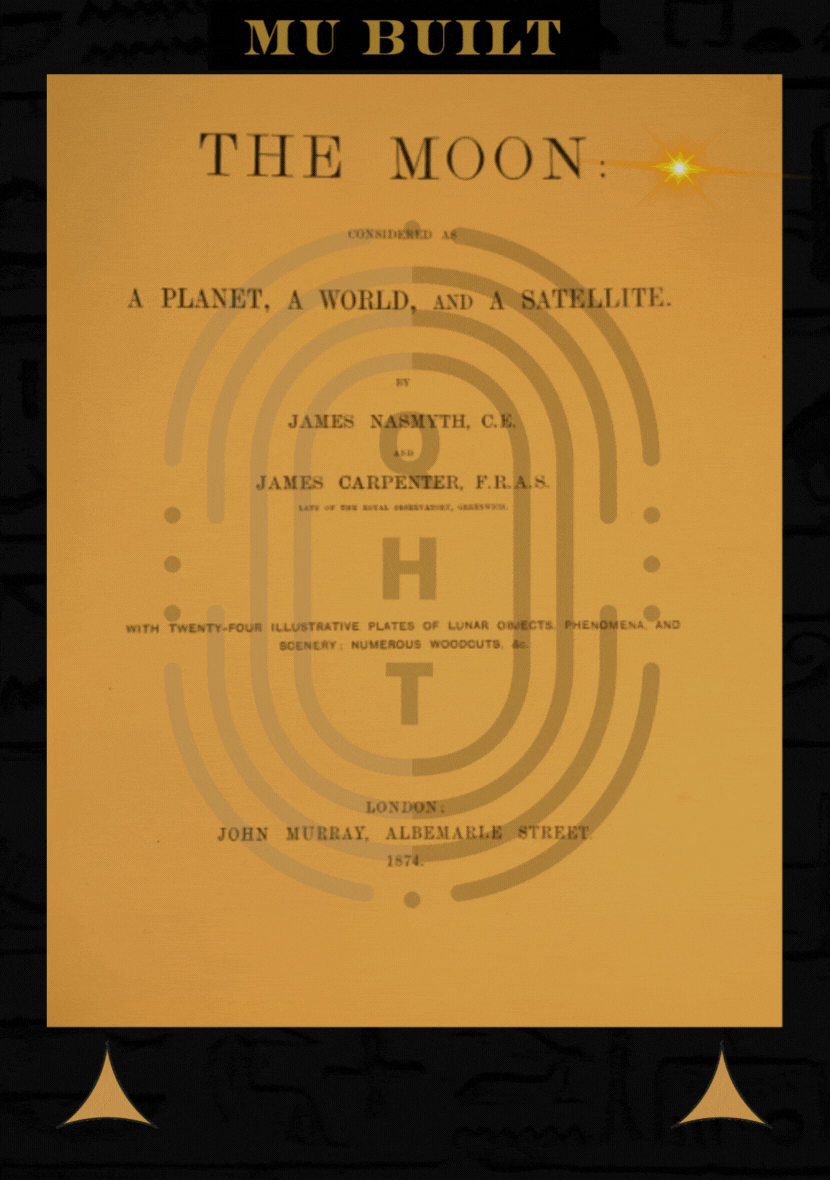
eye bee moon [ibm] matrix [i'm] of quantumharrellmatrix.tech
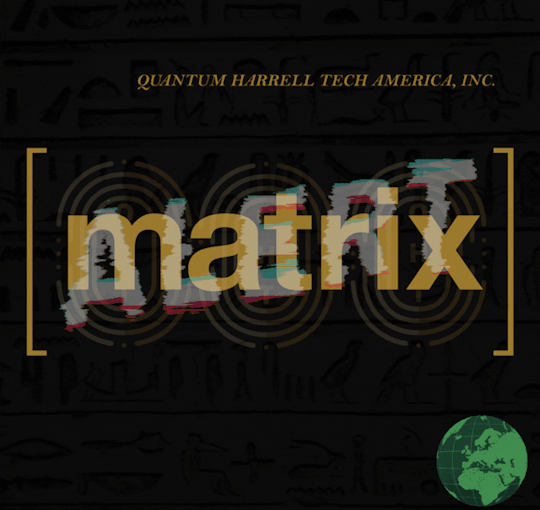
eye see nineteen cad matrix engineer [me] of quantumharrellmatrix.tech?!?!?!

eye quantumharrellufo.tech @ 1921 QUANTUM 2023 HARRELL 2024 T-Mobile 2025 Apple & IBM [A.i.] LLC of ATLANTIS [L.A.]

eye quantumharrell.tech communications on qhtufocad.com domain network of ibmautocad.tech

quantumharrell.tech ufoskymilitary.gov

where your private ufo sky [u.s.] military.gov businesses privately registered @ the defense.gov?!?!?!
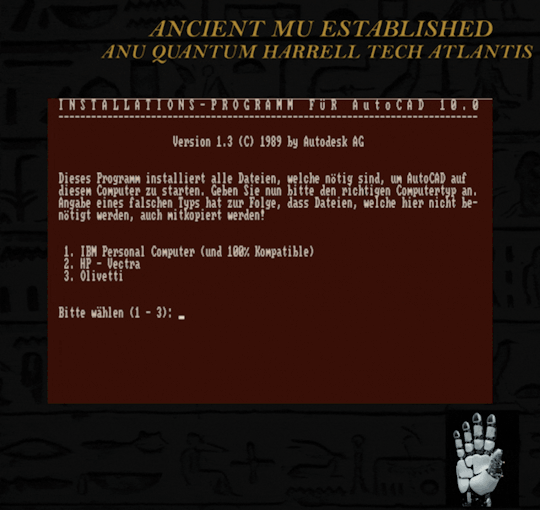
is that a...
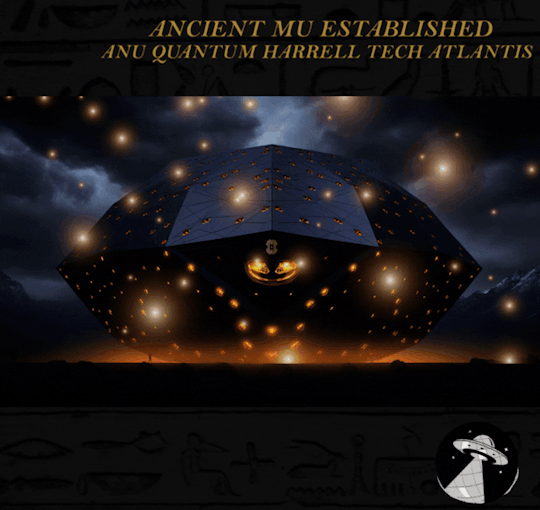
eye triple [e.t.] 6 black budget elite @ 1921 QUANTUM 2023 HARRELL 2024 T-Mobile 2025 Apple & IBM [A.i.] LLC of ATLANTIS [L.A.] 5000

eye kingtutpentagon.tech elite

where the private black ufo sky [u.s.] aliens [usa = anunnagi] at?!?!?!

eye fly ancient [ifá] blackanunnaqi.tech sky ships [hypersonic satellites] that predate you temporal human clones


shhh... it's only 3 sets of us 144,000 ancient [usa] atlantean families in #fallofamerica


quantumharrell.tech sky military budgets @ 1921 QUANTUM 2023 HARRELL 2024 T-Mobile 2025 Apple & IBM [A.i.] LLC of ATLANTIS [L.A.] 5000

quantumharrell.tech defense.gov of ancient kingtutpentagon.tech @ 1921 QUANTUM 2023 HARRELL 2024 T-Mobile 2025 Apple & IBM [A.i.] LLC of ATLANTIS [L.A.] 5000

© 1698-2223 QUANTUM HARRELL TECH LLC All Ancient 9 Ether kingtutdna.com [iTUT®] MILITARY [I'M] Domain [I.D.] Dynasty [I.D.] Property & Economic Rights Reserved @ 1921 QUANTUM 2023 HARRELL 2024 T-Mobile 2025 Apple & IBM [A.i.] LLC of ATLANTIS [L.A.] 5000

© 1698-2223 QUANTUM HARRELL TECH LLC All Pentagon DotCom defense.gov Department Domain Rights Reserved. | © 1698-2223 QUANTUM HARRELL TECH LLC All LOST ANCIENT [L.A.] ATLANTEAN DNA [A.D.] DotCom [A.D.] Domain [A.D.] Name Rights Reserved.
#om#o michael#harrelltut#quantumharrelltech#9etherpentagonelite#u.s. michael harrell#quantumharrelltut#kemet#mu:13#harrelltut.com#king tut#defense.gov#9etherskyanunnaqi#9ethernibiru.tech#9etherjunkdna.tech#humanity is the virus
2 notes
·
View notes
Text
G7 Meeting Addresses Ukraine Conflict, Security

G7 Strengthens Commitment to International Peace
High-Level Meeting Addresses Global Threats The G7 Foreign Ministers, representing Canada, France, Germany, Italy, Japan, the United Kingdom, the United States, and the High Representative of the European Union, convened in New York today to reaffirm their unwavering unity in the face of threats to international peace and security. This crucial gathering emphasized their dedication to fortifying a free and open international order, founded on the principles of the rule of law and upholding the United Nations Charter as the cornerstone of global cooperation.
A Stand Against Unilateral Actions
Resisting Coercion and Force Worldwide The G7 nations came together to express their strong opposition to any unilateral attempts aimed at altering established territorial statuses through the use of force or coercion, regardless of location. Moreover, they pledged to collaborate closely with all United Nations Member States to reinforce the roles of both the UN Secretary-General and the UN General Assembly. The ministers also reiterated their commitment to the reform of the UN Security Council and pledged their unwavering support for the 2030 Agenda for Sustainable Development and its Sustainable Development Goals (SDGs). They underlined their determination to advance all SDGs, promoting peace and prosperity while balancing the social, environmental, and economic aspects of sustainable development.
Standing Firm Against Russia's Aggression in Ukraine
A Continuing Call for Peace More than a year and a half since Russia's full-scale invasion of Ukraine, the G7 members remain steadfast in their commitment to support Ukraine. They condemned, in the strongest terms, Russia's war of aggression and its violation of international law, including the UN Charter. The ministers expressed their strong disapproval of the increasing attacks on civilians and civilian infrastructure, categorizing indiscriminate and deliberate assaults as war crimes. They demanded Russia's immediate, complete, and unconditional withdrawal of troops and military equipment from the internationally recognized territory of Ukraine.
G7 Pledges Ongoing Support to Ukraine
Aid and Commitment to Security The G7 nations reaffirmed their dedication to providing security, financial, humanitarian, recovery, and reconstruction support to Ukraine. They also declared their intention to collaborate with Ukraine on specific, long-term bilateral security commitments. In addition, the G7 members pledged to assist in repairing and restoring Ukraine's civil and critical infrastructure and aiding its domestic reform efforts, particularly in the realms of anti-corruption, the justice system, and the promotion of the rule of law. They celebrated the participation of 29 countries and institutions in these endeavors and encouraged others to join this vital mission.
Rejecting Illegitimate Claims and Supporting Peace Efforts
A Call for a Just and Lasting Peace The G7 countries unequivocally rejected Russia's staged "elections" in the illegally occupied territories of Ukraine. Donetsk, Luhansk, Kherson, Zaporizhzhia oblasts, and Crimea remain integral parts of Ukraine, and the G7 members emphasized that they would never recognize Russia's illegitimate claims over sovereign Ukrainian territory. Furthermore, they reiterated their commitment to supporting concrete efforts for a just and lasting peace in Ukraine, including the development of President Volodymyr Zelenskyy's Peace Formula in alignment with international law.
Condemning Russia's Threats and Actions
A Focus on Food Security Russia's prolonged war of aggression against Ukraine has not only resulted in loss of life and immense suffering but has also jeopardized global access to food and energy. The G7 members strongly condemned Russia's unwarranted and escalated attacks on Ukrainian ports and grain infrastructure in the Black Sea and the Danube. They called on Russia to cease endangering global food security and return to the international framework associated with the UN to resume grain exports from Ukraine. In addition, they reiterated their support for Ukraine's right to export grain and foodstuffs through various initiatives, including "the EU-Ukraine Solidarity Lanes" and its humanitarian maritime corridor. The G7 countries are actively collaborating with nations worldwide to enhance global food and energy security, with a focus on building resilience to withstand future shocks.
Condemning Russia's Nuclear Threats and Actions
Urgent Concerns Over Nuclear Safety The G7 ministers expressed grave concerns over Russia's irresponsible nuclear rhetoric and its threat to deploy nuclear weapons in Belarus. They made it clear that any use of chemical, biological, or nuclear weapons by Russia would result in severe consequences. The members of the G7 voiced their concern about Russia's seizure and continued militarization of the Zaporizhzhia Nuclear Power Plant and called on all nations to support the International Atomic Energy Agency's efforts to enhance nuclear safety and security in Ukraine.
Commitment to Accountability and Sanctions
Pursuing Justice and Sanctions The G7 members reiterated their commitment to holding those responsible for the conflict accountable, consistent with international law, including by supporting the efforts of international mechanisms, such as the International Criminal Court. They also expressed support for exploring the creation of an internationalized tribunal based in Ukraine's judicial system to prosecute the crime of aggression against Ukraine. The G7 nations pledged to maintain and, where appropriate, expand robust sanctions and other restrictions against Russia. They urged third parties to halt any assistance to Russia's war of aggression or face severe consequences. The G7 countries also reaffirmed their commitment to coordinate efforts to prevent third parties from supplying lethal support, including weapons, to Russia.
Engagement with China
Navigating Relations with a Global Power The G7 members not only reaffirmed but further stressed the importance of direct engagement with China, as they recognized the compelling need for cooperative efforts in addressing global challenges and common interests. This acknowledgment underscored their readiness to foster constructive and stable relations with China, urging China's active involvement in international forums dealing with various critical issues such as climate change, biodiversity crises, debt sustainability for vulnerable countries, global health, and macroeconomic stability. In addition to these imperatives, the G7 countries emphasized the paramount significance of economic resilience. They called for strategies involving de-risking and diversification where deemed necessary. Moreover, they emphasized the absolute necessity of ensuring a level playing field for their workers and companies in their economic interactions with China. Simultaneously, they urged China to adhere meticulously to the Vienna Convention on Diplomatic Relations and the Vienna Convention on Consular Relations. Conclusively, the G7 members issued a stern call for China to abstain from activities aimed at undermining the security, safety, democratic institutions, and economic prosperity of their communities, thereby emphasizing the shared responsibility for global stability and cooperation.
A United Stance on the South China Sea
Opposition to Unilateral Actions The G7 members expressed their deep concern regarding the situation in the East and South China Seas. They maintained a strong opposition to any unilateral endeavors aimed at altering the status quo through coercion or the use of force. In addition, they emphasized the universal and unified character of the United Nations Convention on the Law of the Sea (UNCLOS), highlighting that UNCLOS serves as the overarching framework governing all activities conducted in the world's oceans and seas. Furthermore, the G7 countries reiterated their firm stance that China's expansive maritime claims in the South China Sea lack a legal basis. They unequivocally condemned China's actions, which include the militarization of the region and provocative behavior.
A Call for Peace and Stability in the Taiwan Strait
Supporting Cross-Strait Resolution The G7 nations underscored the utmost importance of peace and stability across the Taiwan Strait for the well-being of international security and prosperity. Consequently, they advocated for the peaceful resolution of cross-Strait issues and reiterated their unwavering support for Taiwan's substantial participation in international organizations. In alignment with their commitment to maintaining stability, the G7 members reaffirmed their adherence to their respective One China policies and their resolute stance regarding Taiwan.
Addressing Human Rights and Regional Issues
Concerns Over Human Rights The G7 members expressed concern about human rights violations in China, particularly in Xinjiang and Tibet. They called on China to uphold its commitments under the Sino-British Joint Declaration and the Basic Law, which protect rights, freedoms, and a high degree of autonomy for Hong Kong.
Commitment to a Free and Open Indo-Pacific
Strengthening Regional Relations The G7 members reiterated their commitment to a free and open Indo-Pacific region, based on the rule of law, inclusivity, prosperity, and the protection of fundamental freedoms and human rights. They emphasized their support for ASEAN centrality and unity, pledging to enhance cooperation with the ASEAN Member States in line with the ASEAN Outlook on the Indo-Pacific. The G7 countries also affirmed their partnership with Pacific Island countries, supporting their priorities and needs as outlined in the Pacific Islands Forum's 2050 Strategy for the Blue Pacific Continent. They underscored their commitment to sustainable, inclusive, resilient, and quality infrastructure in partner countries through the G7 Partnership for Global Infrastructure and Investment (PGII).
Addressing North Korea's Provocations
A Unified Call for Denuclearization The G7 members strongly condemned North Korea's continued expansion of its unlawful nuclear and ballistic missile programs, as well as its escalation of destabilizing activities. They reaffirmed their unwavering commitment to the denuclearization of North Korea. Additionally, they issued a resounding call for North Korea to take immediate steps towards relinquishing its nuclear weapons, discontinuing existing nuclear programs, and terminating any endeavors related to weapons of mass destruction and ballistic missile programs. This abandonment must occur in a manner that is complete, verifiable, and irreversible, aligning meticulously with all pertinent UN Security Council resolutions. G7 Russia-North Korea Cooperation Concerns The G7 countries voiced grave concerns regarding Russia-North Korea cooperation, which carries the potential to violate UNSCRs and pose a significant threat to peace and security, not only in the Indo-Pacific region but also on a global scale. They emphasized the urgency of urging all UN Member States to diligently and comprehensively implement the relevant UNSCRs. Furthermore, they called upon UNSC members to uphold and fulfill their commitments in this critical matter. The G7 members also deplored North Korea's systematic human rights violations and called on North Korea to cooperate with the United Nations and comply with its international obligations regarding human rights.
Concerns in the Sahel Region
Commitment to Peace and Stability The G7 members expressed concern about recent developments in the Sahel region. Furthermore, they strongly condemned the attempted military takeover in Niger and called for the immediate release of President Bazoum, while advocating for a return to constitutional order. Additionally, the G7 countries reaffirmed their unwavering commitment to fostering peace, stability, and good governance in the region. They underscored the pressing need to address the root causes of instability, including terrorism and irregular migration. As the G7 Foreign Ministers' meeting concludes, their unified stance on global challenges and their resolute commitment to international peace and security reverberate on the world stage. This underscores the paramount importance of collaboration in effectively addressing today's complex issues. Sources: THX News & US Department of State. Read the full article
#ChinaRelations#G7ForeignMinistersMeeting#Globalfoodsecurity#HumanRightsConcerns#Indo-PacificStability#InternationalPeaceandSecurity#NorthKoreaDenuclearization#SahelRegionDevelopments#SouthChinaSea#Ukraineconflict
0 notes